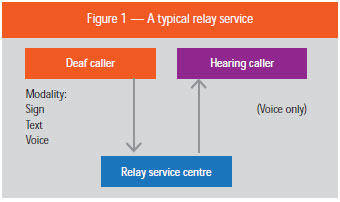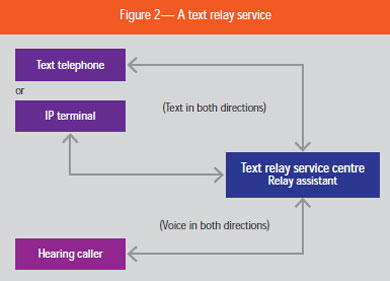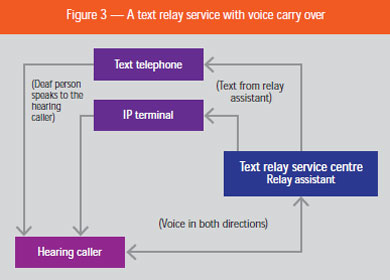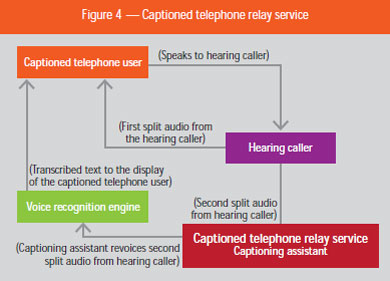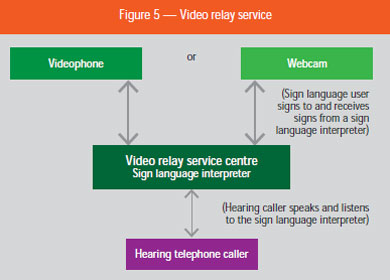|
The St Louis Relay Service
The St Louis relay service (I believe the first one in the nation)
started in a home which served as a wake-up alarm for hearing people.
Imagine that! Racking my poor head, I'm thinking that around 1968, John
Woodard of Western Union suggested I make a personal visit (the home was
just a half mile away) and bring up the idea of a relay service for the
deaf. The manager (probably the owner) agreed to give it a try. Two
dollars per deaf family per month to use it, I think. Service limited to
normal business times and did not include weekends. There were about ten
to fifteen deaf families wanting to give it a try so that amounted to
about thirty dollars per month, not that cheap way back in 1968. Well,
we were dumfounded over the escalating use of the service after only a
few months. The manager called me and said how sorry he was to inform me
that unless we come up with more money he would have to cancel the
service. By that time, a non-profit organization for suicide prevention
learned of the new relay service and volunteered to try it. So, I moved
the equipment over there and service was resumed. Many of the deaf
families said how much they relied on it for important calls and
obviously the service will have to be expanded. By that time, I believe
in 1969, the state of Missouri was alerted of this kind of service
(quite a few hearing people called to alert the state of such an
important service operated only by volunteers). The service went on for
about a year and finally, the state set up something (how dim my memory
is !!!) which was not much better than the volunteers, however, it was a
bit more dependable. Around that time, the East Coast got started with a
relay service in just a few states. For a long time, services were
intra-state only and the pressure built up at the FCC to broaden the
service to nationwide. After the Americans with Disability Act passed in
1990, all fifty states had continuous (7 days, 24 hours) interstate
relay service, FINALLY !!
Paul Taylor
Converse Communications Corporation
(formerly Converse Communications Center) (CCC) as a non-profit tax
exempt organization was first established in the USA in 1974 to provide
telecommunications access for Deaf and Hard-of-Hearing people living in
Connecticut. The state-wide service began on February 11, 1974,
providing telecommunications relay service, 24 hours a day, 365 days a
year. William "Bill" Yoreo and his wife, Grace were the
directors of CCC.
 While
they worked with deaf people at a local church, Bill and Grace realized
that the vast majority of the deaf community were without telephones and
TTYs. They obtained a grant to distribute TTYs to the deaf and hard of
hearing population in Connecticut. David, their son joined them to run
their business. While
they worked with deaf people at a local church, Bill and Grace realized
that the vast majority of the deaf community were without telephones and
TTYs. They obtained a grant to distribute TTYs to the deaf and hard of
hearing population in Connecticut. David, their son joined them to run
their business.
CCC eventually grew from their home to
relocate to a building within the American School for the Deaf campus
and then moved to an office building in Bloomfield.
At the same time, CCC also operated
the captioned TELENEWS Service to broadcast on all five public
television channels and provided live AP News, Sports, and Stock Market
Reports. TELENEWS provided items of local interests, a calendar of
events, and weather reports.
In addition, CCC manages the TTY Loan
Program, along with their popular state-wide TTY directories, which are
updated on an annual basis. With the changing business environment and
the entry of the Americans with Disabilities Act in 1993, CCC became a
partner with Relay Connecticut, providing the TTY Loan Program for deaf,
hard-of-hearing and speech-disabled people living in Connecticut.
Currently, CCC distributes TTYs to the
deaf, hard-of-hearing and speech-disabled people in Connecticut. Repair
services are included in this program. TTY directories are generated on
an annual basis.
Additionally, CCC sells a large
variety of custom-made equipment for telecommunications and
accomodational needs, ranging from TTYs, Alarm Clocks to Doorbell
signalers and Payphone TTYs.
Please visit CCC's
web site for information.
Directions to:
Converse Communications Corporation
34 Jerome Ave
Bloomfield, CT 06002-2463
|
|
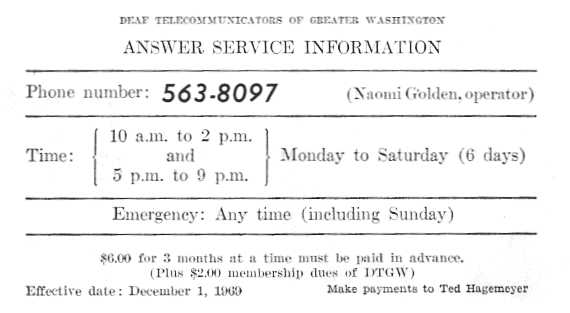
HI-LINE RELAY

Lester
Zimet had HI-LINE's Phonetype 5 - Look we brought it to life and
it typed to us!
Message is in ROM in the modem... It is like a voice... for
the past...
Hi-Line is a third party relay service for the hearing
impaired. Through Hi
Line the hearing impaired person has a portion of normal access to the
tele
phone as the hearing person. Hi-Line was started after a direct request
was
received from the President of the Rochester Tel-Com Association of the
Deaf
stating:
"The greatest need of the hearing impaired person is a third
party answering service which will enable the telecommunication
device (TTY/TDD) user to communicate his/her everyday needs."
Thus, in February, 1979 a volunteer relay service began. In June, 1979
CETA
funding was obtained and a paid staff was hired. In October, 1980
Hi-Line
became a joint program of the Monroe County Association for the Hearing Im
paired (MCAHI) and Handicapped Independence Here, now named the
Rochester
Center for Independent Living (RCIL), funded by the Office of
Vocational
Rehabilitation (OVR) and the United Way of Greater Rochester.
Currently the hours of the Hi-Line Relay Service are as follows:
Monday - Friday: 7 am - 9 pm
Saturday: 9 am - 5 pm
Sunday: 10 am - 2 pm
The service is generally closed for all recognized holidays (ie:
Christmas,
Thanksgiving, Labor Day, etc.).
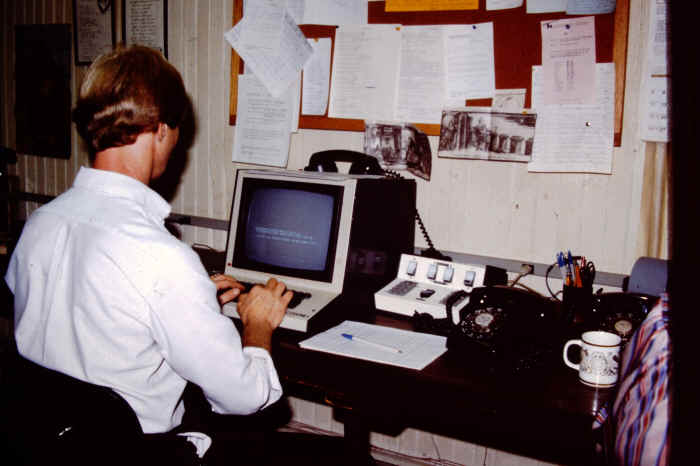
C- SMECC From the Paul and Sally Taylor Collection at
SMECC
C-Phone In use
Sally Taylor tells us - "In this
photo the C-Phone was used by a relay service set up in Rochester, New
York... Called the Hi-Line Answering Service, it operated for
several years with limited hours, such as from 8 to 5 Monday through
Friday, and no weekend calls. This service was managed by the Monroe
County Association for the Hearing-Impaired. Eventually Paul pushed for a
24/7 service, and it went nation-wide, thanks to the signing of the ADA in
1990."
| The Deaf
Insurrection Against Ma Bell Harry G. Lang states - "The
burden on local services was overwhelming. Hi-Line Relay Service
in Rochester, for example, was handling 163,497 calls with only
four operator positions . There was a blocking rate (TTY callers
getting busy lines) of 30 percent)" |
ROCHESTER ADVOCATE
NOVEMBER 1979
Of interest to all hearing-impaired
persons is the H-line answering service
(244-1690), a new program of Monroe
County Association for the Hearing
Impaired. Ye editor has used it and found
it very helpful in talking to a hearing friend
who does not have a teletypewriter. The
Hi-Line operates from 9:00 a.m. to 9:00
p.m. Mondays thru Fridays. It can be used
by hearing people when they need
assistance in reaching their hearing
impaired relatives or friends.
ROCHESTER ADVOCATE
NOVEMBER 1982
A fund-raising carnival was held in
the RSD Gym on February 18. Hosted
by various Rochester organizations for
the deaf, the funds raised contributed to
sustaining the Hi-Line Telephone Service
for the Hearing-Impaired in
Rochester.
Alumni Notes -
A Carnival held on February 8, 1983,
was very successful in raising over
$1000 for the Hi-line communication to
continue its useful services to the
hearing-impaired members. The idea of
a carnival was suggested by 15 Rochester
area deaf organizations. The carnival
lasted from 7 P.M. to 11 P.M. and held all
sorts of amusements. Helen Richardson
won the top prize of $250 and Jenny
Clupper (daughter of Diane Clupper)
won the second one of $150. Involved in
much of the work were Dorislee Grann
and John Ratcliffe
|
Chapter 26: The Short History of Text Telephones
-p238-
Chapter 26: The Short History of Text Telephones
Stephen von Tetzchner
When Bell invented the telephone in 1876, this represented a crucial step in the history of telecommunications; the introduction of the telephone made it possible for the general public to use their own voice to communicate over a distance instead of having to write down messages and ask a telegraph operator to relay them to the other part. For some people, that is, for those who cannot hear or speak, the general development implied a more difficult situation because they were unable to use telecommunication in the same manner as others. They were not able to take part in many new developments in society, because they lacked the possibility of direct communication with people at other geographical locations. While society at large changed, the communication patterns of deaf and speech impaired people remained very much the same.
However, it is not, of course, the development of audio telephones in itself that should be criticised, but the lack of interest for the situation of those who could not use this service. After all, the first telecommunication service, the telegraph, was based on transmission of letters, and from the perspective of speech and hearing impaired people, it seems rather surprising that it should take almost one hundred years before text communication was made available for personal use.
The short history of the text telephone, compared to the history of the audio telephone, started in the USA, where the first text telephone, or a least an approximation of it, was "invented" in 1964. As has often been the case with new developments for, and movements of, disabled people, Europe was somewhat later on the stage than the USA. But equally typical, Europe has caught up, and today, several European countries have better equipment and services than the USA.
1 The First Text Communication Devices: The USA
The implementation of personal text communication devices was mainly a result of expensive equipment becoming obsolete, combined with some creative intervention. In the beginning of the 1960s, the teletypewriters (telex machines) developed early in the 1930s for document transmission, were beginning to be replaced with more modern ones. In 1964, Robert Weitbrecht developed an acoustic coupler that allowed two teletypewriters (usually called TTY) to communicate over the telephone network (Bellefleur, 1976).
The teletype machines were huge, weighed around 25 kilos and were not well suited for a living room. The conversation was written on paper, which is probably the reason why deaf people have got into the habit of demanding prints of conversations. There was also a range of user-hostile features, such as independent carriage return and linefeed, so that when the user forget to do both operations, there would be a black mark at the end, or a new line of text over the previous one (Geoffrion, 1982). But such matters were of minor importance for the users compared to the fact that at last they had obtained access to personal telecommunication without having to use an interpreter.
From 1964 to 1968, only 25 machines were operational, but from 1968 to 1975, the number increased to about 5 000 units. Most of them were of the old type which was designed some 40 years earlier. Little was done to modernise the equipment, and although for the last ten years there has been talk about moving away from the 5-bit Baudot code not used by few others in the world today (cf. Castle, 1981; Pflaum, 1982; Middleton, 1983), it is still this standard that is in common use (there are couple of devices which can communicate with both ASCII and Baudot). There have, of course, been newer models; in the 1970s, new, instead of reconditioned equipment came on the market, and in 1980, there were 10-15 different manufacturers (Castle, 1981). New models are usually called TDD (telecommunication devices for the deaf). Some of these had hard print, others had small displays, as well as automatic answering facilities, but in general, both functionality and technical standards are the same as the out-of-date units 30 years ago. The typical TTY today has a one or two line display with 32 characters and a transmission rate of 45,5 bit/s.
It has been claimed that more modern equipment would have been more expensive, and that this was the reason why Weitbrecht developed the TTY on out-of-date technology. Deaf people could get reconditioned surplus teletype equipment relatively cheap; that is, initially the average price was $ 2 000, which by 1982 was reduced to $ 1 000 and to $ 500 in 1987 (House document No. 9, 1988; Levitt, 1982). Many deaf people belong to low- income groups, and even at this price, they found the units hard to afford, and for example in the state of Virginia, in 1987, only 27 per cent of potential users had a text telephone. This led to an initiative to provide free text telephones to those who could document a need (House Document No. 9, 1988).
On the other hand, the Baudot standard is extremely slow, and the user may lose on the swing what he or she gains on the roundabout. The use of low cost TTY machines represented a major step forward, but at the same time painted deaf people into a corner by excluding them from communication with other possible text communication devices, that is, in the USA, computers (Middleton, 1982).
A factor that has contributed to conserving the use of old-fashioned technology is probably the fact that in several American states, telecommunication equipment is provided by the telecommunication companies at the same price as ordinary equipment. For example, in 1979, Senate Bill 597 became law in California, requiring telephone companies to provide text telephone devices to certified hearing and speech impaired people free of charge (Pflaum, 1982). While applauding this development, one should consider the risk that telephone companies do not want to develop new equipment if this means higher distribution costs later.
1.1 Services
The first services to appear were emergency services where a call could be directed to a hearing volunteer with a TTY who would then relay a message to the police, hospital or fire brigade. In 1980, Bell Telephone Systems installed a special nation-wide toll-free TDD number that allowed TDD users to get assistance from a telephone operator (Castle, 1981).
The first relay service was established in St. Louis in 1969 as part of a private answering and wake-up service, serving 20 deaf families. The service was discontinued after six month because the time it took to relay a conversation was much longer than expected. A new service was started up in 1972 "when a volunteer organization offered services which, even to this day, have been woefully inadequate in meeting the telephone needs of the hearing impaired population in St. Louis" (Taylor, 1989, p. 13).
A number of similar small operations appeared in the 1970s; some larger ones were also established, such as the Hi-Line Relay Service of Rochester, New York, which handled 163 497 calls in 1987. In spite of the large number of relayed calls, with only 4 operators, the blockage rate was 30 per cent (Taylor, 1989). There is no doubt that the lack of nation-wide, or at least state-wide, services have severely hampered the possibilities of deaf and speech impaired people to make full use of telecommunications.
The first state-wide service was opened in California in 1987, followed by Arizona and Washington. In its first month, January 1987, the California relay service handled 87 511 calls, in January 1988, 200 718 calls were relayed, and the number of operators were increased from the expected 60 to 120 persons (Shapiro, 1989). It is worth noting that all of the first three state-wide services were a result of state legislative action, indicating that this sort of major intervention, as relay services represent, must come through legislative action.
With regard to relay services, the USA is still not one country. More than 300 relay services are geographically scattered with different names and telephone numbers (Baquis, 1989). In 1989, 24 states had either established state wide relay services or were in the process of legislation (Taylor, 1989). In 1991, there were 31 states with such relay services and 11 states are planning such services (Currie, 1991).
In addition to relay services, a number of commercial services appeared, some of them very soon after the text telephone had arrived. In some shopping centres, TTY shopping was possible, but it did not work well, and mistakes in the orders were common. The National Railroad was also quick to establish a TTY service. It is notable that this service is not yet available in Europe in 1991, without the help of a relay service. Interestingly, a number of news centres for deaf people appeared, that is, TTY users could dial a special number and get a news print. These services preceded later teletext on television as well as today's visions of future newspaper distribution. Additionally, a TTY radio news service was initiated in Philadelphia, where the recipients had a small radio tuner, and the audio signal triggered the TTY which printed out the message (Bellefleur and Bellefleur, 1979).
2 Development in Europe
While the development in the USA is reasonably well documented, there is a scarcity of available information about the development in Europe. Several countries that have text telephones are not mentioned in this review due to lack of information. The introduction of equipment and services has been almost as piecemeal as in the USA, with the exception that services were usually nation-wide when initiated. There are still, however, many countries without text telephones, and most European countries do not have a relay service (cf. chapter 22).
The first text telephones to be used in Europe were personal imports from the USA, bought during travels abroad. However, the distribution was rather small, and there is no record of any large number of deaf people being interconnected with TDDs (Abbink and de Graaf, 1985).
The first country to manufacture and sell text telephones seem to be Germany in 1976. This happened without any participation from government; the "Deutsche Schreibtelefon", which used the EDT standard (European Deaf Telephone) was also sold in Austria, and, to some extent, in Switzerland.
Text telephones appeared early also in the UK, although there was never developed a text communication device with deaf and speech impaired people in mind. The British videotex system, Prestel, which was introduced in 1978, allowed direct communication between individual users, and thus this was used for text communication by deaf people. In 1986, a text communication device intended for document transfer in offices based on V21 was adopted as text telephone by deaf and speech impaired people. This system is currently the most widely used, but there is still a considerable degree of incompatibility. The incompatibility has even increased in 1990 and 1991 with the marketing of American TDDs based on the Baudot standard in the UK and Ireland. Those who sold Baudot-based text telephones obviously disregarded the fact that text telephones of more modern standards had already been on the market for several years, and one may assume that not many people would have bought this equipment if they had known of the incompatibility and that the relay service in the UK would not accept the Baudot standard.
Around 1980, several countries started to manufacture text telephones. Sweden began production of Diatext 1, which was based on V21, in 1979, and this text telephone was adopted also in Finland and Norway shortly thereafter.
In France, several "tlphone par crir" was commercially available in 1981; the most known is Portatel. However, in 1982 the videotex system "Minitel" was introduced, and in the following years, the French Telecom gave away four million terminals as electronic telephone directories. In 1986, Minitel Dialogue was introduced to the benefit of deaf and speech impaired people. This model allowed direct communication between two Minitel users if one of them used the Dialogue, and Minitel has to a large extent replaced other text telephone devices (Besson, 1990; Xech and Rimbault, 1987). The large number of terminals given away for free, and the low charges of renting has made text communication widely available in France, which is also reflected in the reduction of relay service use.
In the Netherlands, a trial with four text telephones was initiated in 1981 which was followed by other small-scale trials until, in 1984, a commercial model based on DTMF was presented on the market (Abbink and de Graaf, 1985).
Denmark performed some experimental trials with text telephones in 1979, but they did not appear on the market until 1986, mainly because of funding problems. The Danish text telephone was based on the Commodore +4, for which, due to failing sales, the Danish Telecommunication Administrations got an extremely advantageous offer (Dam, 1987). Somewhat surprisingly, in Denmark, the DTMF was selected instead of the V21 which was already in use in the other Nordic countries, except Iceland where the American text telephones based on the Baudot standard had been in use since 1985. Iceland is presently in the process of changing to computer-based text telephones and ASCII by adopting the Norwegian text telephone program (cf. chapter xx).
2.1 Services
With a few noticeable exceptions, relay services in Europe are still in their infancy or not even born (cf. chapter 22). The first European relay service seemed to have started in the UK, where a pilot relay services was set up by the Royal National Institute for the Deaf in London in 1980, but the further development was slow. In 1985, a regular service was launched under the name "The RNID Telephone Exchange for the Deaf" (TED). That system could, however, only cater for 170 subscribers, which, of course, was vastly inadequate to serve the total population of deaf and speech impaired people in the UK. Deaf and speech impaired people had to wait for more than ten years, until 1991, before a unit was set up to handle text communication nation-wide. This service is also run by The Royal National Institute of the Deaf, and is independent from all the major national operators.
The first nation-wide or state-wide relay services ever, appeared in Finland and Sweden. Finland had a trial service in 1981 that was made permanent in 1982, the same year as Sweden started its service. Norway followed in 1984.
In the Netherlands, a small pilot service, serving a few deaf people, was set up in 1984, and after 2 years, a regular service was initiated. In Denmark, the relay service started simultaneously with the introduction of the Danish text telephones, that is, in 1986.
In Switzerland, the multi-lingual situation seems to create certain problems. A relay service was first initiated in the German-speaking part of the country, in 1988, while a relay service for the French speaking part was opened in 1989.
3 Learning from History
The lesson from history is that some sort of regulative action may be necessary to ensure that disabled people get the equipment necessary to give them a more equal footing; that is, making society as accessible to them as possible. Both in Europe and America, development has been slow, and there are considerably fewer text telephones than people who need them.
The unfortunate situation in the UK, with three different and wholly incompatible standards, amply demonstrates that commercial interests may be contradictory to the interest of the consumers, and that there is a need to regulate the market in order to establish the degree of telecommunication interchange that is expected in modern society. It is hard to imagine a similar historical development, with lack of interconnections between countries, for the ordinary audio telephone.
The long and frustrating road towards state-wide and nation-wide relay services in the USA and the limited distribution of such services in Europe again demonstrates the necessity of legislative action to obtain private or public funding for a service that is a necessity for hearing and speech impaired people to obtain equal access to telecommunication. In the USA, sufficient relay services have in most cases come only after legislative action, and as Europe is moving towards increased liberalisation, similar development may be expected there.
References:
Abbink & de Graaf
Baquis, D. (1989). TDD relay services across the United States. In J.E. Harkins and B.M. Virvan (Eds.), Speech today and tomorrow: Proceedings of a conference at Gallaudet University, September 1988. Washington: Gallaudet University, pp. 25-43.
Bellefleur, K.M. & Bellefleur, P.A. (1979). Radio-TTY: a community mass media system for the deaf. The Volta Review, 81, 35-39.
Bellefleur, P.A. (1976). TTY communications: its history and future. The Volta Review, 78, 107-112.
Besson, R. (1990). Minitel for people with disabilities. Proceedings of the Second European Conference on Policy Related to Telematics and Disability, pp. 106-109.
Castle, D.L. (1981). Telecommunication and the hearing impaired. The Volta Review, 83, 275-284.
Currie, K. (1991). Personal communication.
Geoffrion, L.D. (1982). The ability of hearing-impaired students to communicate using a teletype system. The Volta Review, 84, 96-108.
House Document No. 9. (1988). Equal telecommunications access for deaf hard of hearing Virginians (TDD/Message relay programs). Richmond: Commomwealth of Virginia.
Levitt, H. (1982). The use of a pocket computer as an aid for the deaf. American Annals of the Deaf, 127, 559-563.
Middleton, T. (1983). DEAFNET - The word's getting around: local implementation of telecommunications network for deaf users. American Annals of the Deaf, 128, 613-618.
Pflaum, M.E. (1982). The California connection: Interfacing a Telecommunication for the Deaf (TDD) and an Apple computer. American Annals of the Deaf, 127, 573-584.
Shapiro, P. (1989). California relay service. In J.E. Harkins and B.M. Virvan (Eds.), Speech today and tomorrow: Proceedings of a conference at Gallaudet University, September 1988. Washington: Gallaudet University, pp. 85-88.
Taylor, P.L. (1989). Telephone relay service: rationale and overview. In J.E. Harkins and B.M. Virvan (Eds.), Speech today and tomorrow: Proceedings of a conference at Gallaudet University, September 1988. Washington: Gallaudet University, pp. 11-18.
Xech, S. & Mathon, C. (1987). Le Minitel Dialogue: un nuveau moyen de communication
distance au service des personnes atteintes de surdit svre ou profonde. Thesis, University of Paris.
|
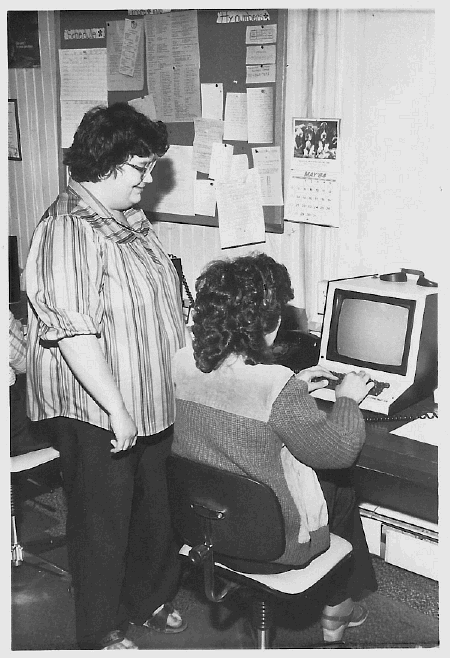
(From the Matthew Starr Collection at SMECC)
|
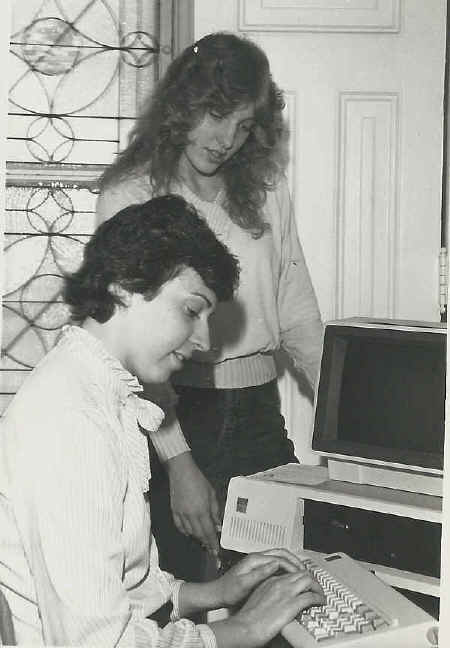
(From the Matthew Starr Collection at SMECC)
|
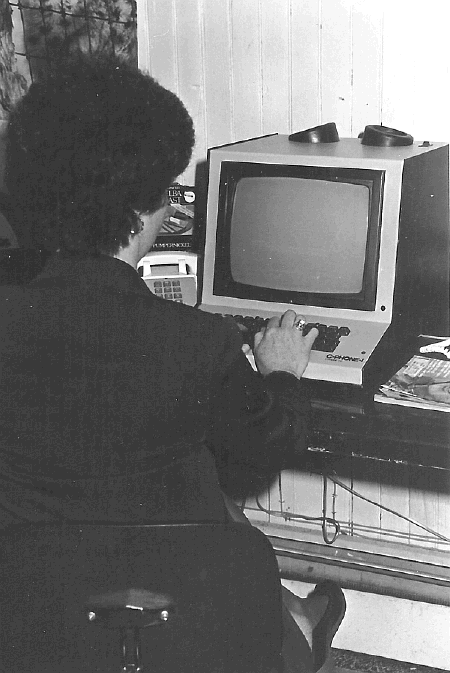
(From the Matthew Starr Collection at SMECC)
|
|
| |
|
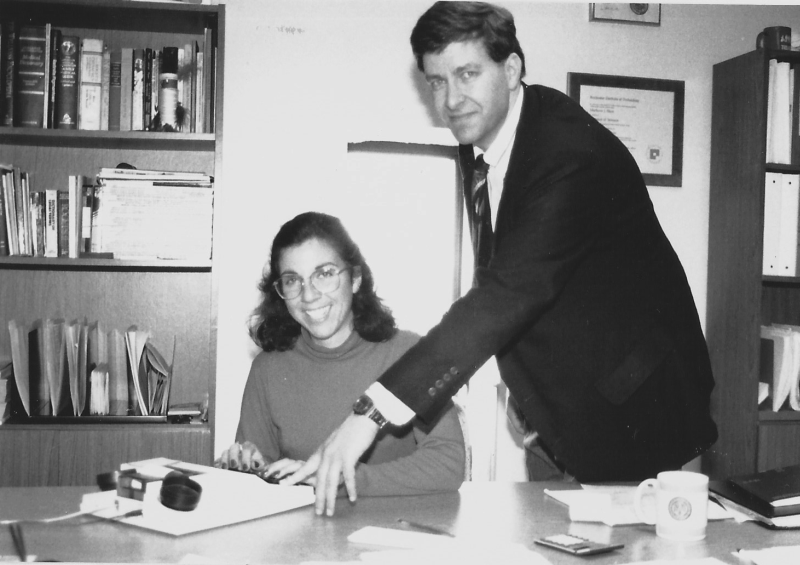
(From the Matthew Starr Collection at SMECC)
Matthew Starr
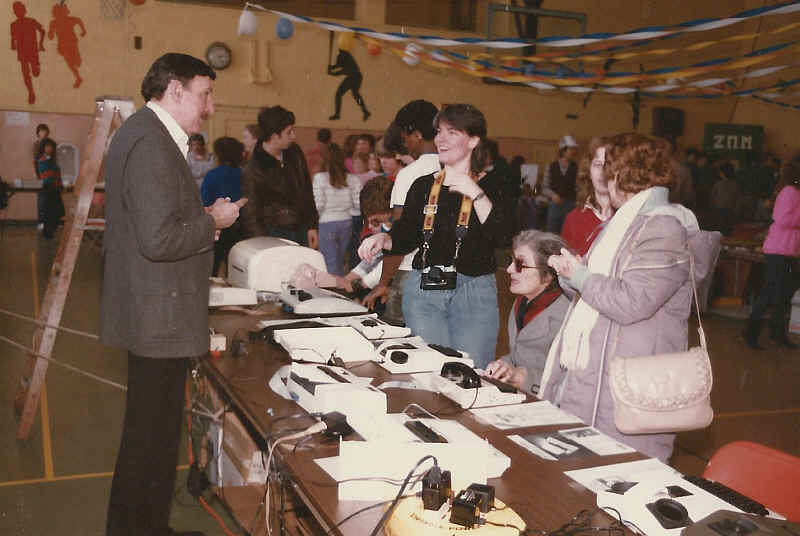
(From the Matthew Starr Collection at SMECC)
Sally Taylor States - "photo
shows Lester Zimet most likely promoting TTYs at a Deaf Awareness event in
Rochester.
("Deaf Expo", most likely just local)"
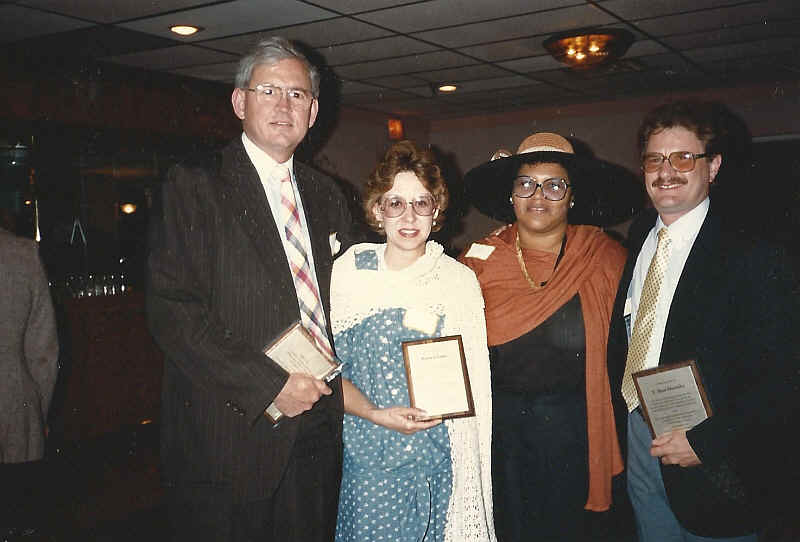
(From the Matthew Starr Collection at SMECC)
Sally Taylor tells us: Four people in next photo:
They were all being recognized during Deaf Awareness Week which was held
annually (or every two years), and MCHI would award one from each
category: cannot remember what they were. (I wonder if the DRN was in
publication at that time? I could check it out...but I doubt it as I
don't remember writing about it. I could be wrong.
Paul for his dedication by serving as advocate for development and
creation of the statewide TDD Relay Service (I just sent you a separate
photo of the award from my Iphone); Patti Lago-Avery, most likely for
her advocacy for deaf/vision-impaired people like herself; Maxine
Childress-Brown (a CODA) who was former Rochester City Council member
who advocated for the deaf people of Rochester in various ways
(wonderful woman!!!); and Alan Hurwitz (now Gallaudet U. President) most
likely for serving as president of the Empire State Association of the
Deaf (NY State) or his advocacy for closed captioning on local CBS news
(you got pictures I sent of the rally downtown to push CBS to caption
their TV programs). If you google Maxine, you'll find she just published
her memoirs which I haven't seen...last year. There is a TV program
showing her being interviewed, but alas no captions on this one I found.
Wonder if she mentioned her deaf parents, etc. etc.
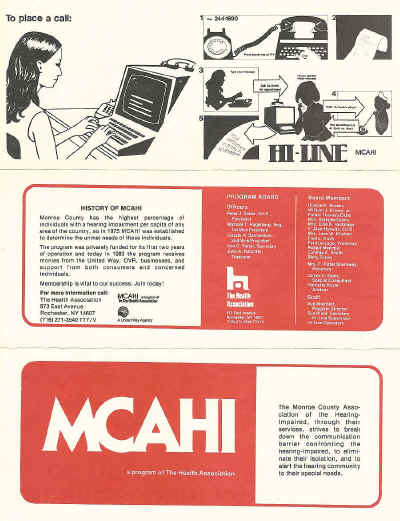
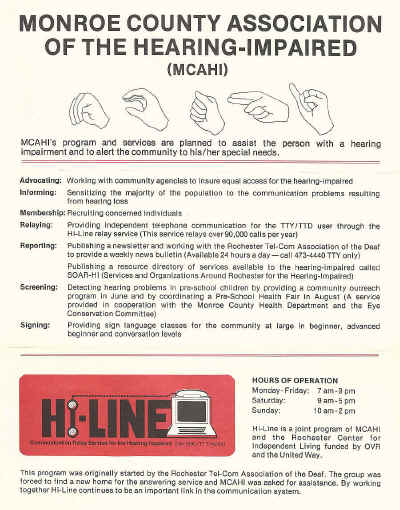
(From the Matthew Starr Collection at SMECC)
HI-LINE/TEL-MED POLICY MANUAL
JOB DESCRIPTION
OPERATOR
Qualifications:
High School graduate; accurate typing skills (40-50 wpm);
ability to work with people.
Responsibilities:
1) Relay telephone calls between hearing and hearing impaired people.
2) Maintain strictest confidentiality of all calls.
3) Answer calls and provide taped information on the Tel-Med System for both
hearing and hearing impaired people.
4) Answer TTY calls for the H.A. Programs on extension 30 and transfer calls
or take messages. (as a back-up to the H.A. Administrative Clerk)
5) Record all calls (Hi-Line, Tel-Med) on the appropriate logs.
6) Fill all scheduled shifts. Obtain sUbstitutes as needed. Notify the
Shift Supervisor and/or Hi-Line Supervisor well in advance if unable to
locate a substitute.
7) Take appointments for Ear and Eye Screenings from hearing/hearing impaired
people as a back-up to the MCAHI secretary. (seasonal)
8) Monitor performance of each C-Phone, as necessary, on a log. (functional
problems, etc.)
9) Attend training and staff meetings as necessary.
10) All operators are responsible to and under the direct supervision of the
Shift Supervisor.
- 2 -
JOB DESCRIPTION
.~ SHIFT SUPERVISOR
Qualifications: High School graduate; accurate typing skills (40-50 wpm);
previous supervisory experience desired, but not necessary;
ability to work with people.
Responsibilities:
1) Perform all duties as listed for the Hi-Line Operator.
2) Evaluate operators on a day-to-day basis and report any problems to the
Hi-Line Supervisor, when necessary.
J) Assist Hi-Line Supervisor in operator performance evaluations to take
place three months after initial hiring and to continue once every six
months thereafter.
4) Document all instances of operator tardiness or disciplinary problems
on the proper forms and refer to the Hi-Line Supervisor.
5) Handle consumer problems/complaints (hearing or hearing impaired) as
they arise and refer to the Hi-Line Supervisor~ if necessary.
6) Inform Hi-Line Supervisor immediately in the case of major equipment
failure/malfunction.
7) Opening/Closing/Cleaning of the Tel-Med System. (Including proper log
ging of daily/overnight calls.)
8) Opening/Closing of the Hi-Line Service.
9) Acquire knowledge of the H.A. Alarm System and be responsible for
openings/closings of the Annex, as needed.
10) Attend training and staff meetings, as necessary.
11) All Shift Supervisors are responsible to and under the direct supervision
of the Hi-Line Supervisor.
- 3 -
JOB DESCRIPTION
HI-LINE SUPERVISOR
Qualifications: Post secondary school education; supervisory experience;
good organizational abilities; accurate typing skills
(45-50 wpm); ability to work with people; sign language
skills helpful.
Responsibilities:
1) Supervise and direct the Shift Supervisors.
2) Participate in Hi-Line operator interviews and be responsible for their
training and scheduling.
3) Fill in as Hi-Line operator as needed.
4) Conduct performance evaluations on Hi-Line operators (assisted by the
Shift Supervisors) and Shift Supervisors to take place three months
after initial hiring and to continue once every six months thereafter.
5) Report repeated instances of tardiness or disciplinary problems to the
~ H.A. Personnel Director.
6) Handle consumer problems/complaints (hearing or hearing impaired) as
they arise and refer to the Program Director, if necessary.
7) Be aware of any equipment malfunctions and arrange for repairs as needed.
8) Train Shift Supervisors on the H.A. Alarm System.
9) Tabulate and prepare statistics from Hi-Line and Tel-Med calls.
10) Arrange meetings and training sessions.
11) Attend meetings as scheduled (Hi-Line operator staff and Shift Super
visor staff).
12) The Hi-Line Supervisor is responsible to and under the direct super
vision of the Program Director.
- 4 -
HOW TO OPERATE THE TELEPHONES
1) Position the headset firmly on your head, making sure that the mouth piece
is directly in front of your mouth and that the earplug fits properly in
your ear.
2) When the phone rings, switch the incoming phone button to the "ON" position.
Also, switch the two middle buttons to the Headset position (UP). Answer
by saying "Good Morning/Afternoon/Evening Hi-Line. Mary here." or "Hi-Line.
Mary here. May I help you?"
I
3) If there is no response, assume the caller is hearing impaired and switch
the· two middle buttons to the Handset position (DOWN). Type "Hi-Line.
Mary here. May I help you? GA" or "Good Morning/Afternoon/Evening. Hi
Line. JOIm here. GA"
4) If the caller is a hearing person, leave the two middle buttons in the
Headset position. (Up)
5) When calling a hearing person, switch the outgoing phone button to the
"ON" position (you will hear the dial tone) and dial the number.
6) When calling a hearing impaired person, switch the outgoing phone button
to the "ON" position (you will not hear the dial tone) and dial the num
ber. You will be able to tell if their phone is ringing or if it is busy
by watching the red light on the C-Phone. If it flashes quickly, the
phone is busy. If it flashes slowly, the phone is ringing.
7) To disconnect callers, switch the phone (incoming/outgoing) button to the
"OFF" position.
S) The Voice button between the two phone dials can be used to prevent the
hearing person from hearing your voice. When it is in the "ON" position,
the caller will be able to hear you. When it is in the ."OFF" position,
the caller will not be able to hear you, but you will be able to hear them.
This button should only be used as a 'courtesy to the hearing party. For
example: if you have to cough, sneeze, etc.
- 5 -
HOW TO OPERATE THE C-PHONE (TTY)
The Keyboard
The C-Phone's keyboard resembles a typewriter's keyboard. You do not have to
shift keys, except for most punctuation marks.
Making a Call
1) Turn on the C-Phone using the red ON-OFF switch on its top. Almost immedi
ately you should see the cursor (a small, white, rectangular spot of light)
on the lower left corner of the screen.
2) The telephone handset should already be positioned in the rubber cups at
the top of your C-Phone. Be certain that the cord end of the handset is
in the cup marked CORD (the cup that is opposite the red ON-OFF switch).
3) To call a TTY user: Switch the outgoing phone button on the telephone to
the "ON" position and dial the number. Press the return key on the C
Phone to release the cursor. (This step is not always necessary for every
C-Phone or TTY/TDD you use, but there are some models that require this
step.) Once the party has answered you may begin to type your message.
The C-Phone will automatically return at the end of each line. The re
turn key can be used at any time to control the appearance of your message.
When an error is made in typing, simply type the letter "X" a few times
and then continue with the correction. (ie: JOHN IS CALLIGNXXX CALLING ... )
Finishing a Call
When your conversation is over, type "SK" and wait for the other party to re
spond with "SK" as well, to signal the end of the conversation. Switch the
outgoing phone button to the "OFF" position. Hold the CLEAR key on the C-Phone
down for a few seconds to clear the message from the machine.
- 6 -
CONFIDENTIALITY
Confidentiality means that the trust and confidence callers have placed in us
is respected by never revealing the identity or concerns of persons calling
Hi-Line to those outside of Hi-Line, except in life-threatening instances,
ie: suicide.
Each operator signs a pledge of confidentiality as an indication of their
awareness and acceptance of the high ethical standards vital to the work of
Hi-Line. (see figure 1)
Never give out the TTY/TDD user's phone number. If anyone wants the phone
number of a hearing impaired person, you can call that person and ask their
permission to give out their number. Clear the C-Phone after each call is
finished. (If a paper print out is used, rip up the message.)
CODE OF ETHICS FOR OPERATORS
The Registry of Interpreters for the Deaf, Inc. has set forth principles of
ethical behavior to protect and guide the interpreter and the consumer (both
hearing and hearing impaired), as well as to insure for all, the right to
communicate.
Although Hi-Line operators are not considered interpreters, we have set up
a Code of Ethics for operators, patterned after the guidelines which were
set up for interpreters.
1) The operator shall guard a LL confidences entrusted to them.
2) The operator shall render faithful interpretations, always conveying con
tent and intent of the speaker.
J) The operator shall NOT counsel, advise, or interject personal opinion
while functioning in the role of the operator.
5 )
The operator shall refrain from interpreting when family, close, personal,
or professional relationships may effect impartiality.
An operator shall use the language mode most readily understood by per
sons for which they are interpreting.
- 7 -
TTY TERMS/ABBREVIATIONS
GA: "go ahead"
GA or SK (GA to SK):
used at the end of a thought when the other person's re
sponse is wanted.
This is used at the end of the entire conversation. It
means that person is entirely finished and is hanging up.
Both mean basically the same thing. The person is say
ing, "I'm finished with what I have to say and am signing
off unless you have something to add." In other words,
"go ahead or sign off".
SK: "stop keying"
TTY: Teletypewriter
TDD: Telecommunication Device for the Deaf
PLS: Please
HD: Hold
TNX: Thanks
ASM: As soon as possible
CUL: See you later
ore. Dh, Lsee
1LY: I love you ANSWERING/RELAYING CALLS
1) Always answer the phone using voice first. Say, "Good Morning/Afternoon/
Evening Hi-Line. Mary here. May I help you?" If no one answers, assume
the caller is hearing impaired and switch the middle two buttons on the
telephone to the handset position.
2) Type "Hi-Line. Mary here. May I help you? GAt!. Always identify your
self and Hi-Line when answering both the phone and the TTY. The caller
has the right to know which operator will be assisting with his/her call.
3) After receiving the information from the caller, (their name, the name of
the person or place they are calling, the phone number) tyPe or ~a~_"PLS
HD" (please hold) or some phrase that indicates that you have recei ve-d
their message and are carrying out the request.
After dialing the number, either type "R" every time the phone rings for
the TTY caller so that he/she is aware of how many times the phone rings,
or if the caller is hearing, tell them_that the~phone is ringing .
. 5r-i) l U
- 8 -
5) After getting the party on the line, identify yourself as "The Hi-Line
Relay Service for the Hearing Impaired" and say, "I have a call for (who
ever), please hold". Sometimes, especially when calling a business that
has never received a call via Hi-Line, you may have to briefly explain how
the service operates. It is important to say "relay service" and not
"answering or interpreting service". We do not take messages or interpret,
we just relay messages. Also, use the term "hearing impaired". This term
covers both hard of hearing and deaf people.
6) After you have identified yourself to the callee, tell the caller that you
have their party on the line and that they may go ahead with their message.
7) The hearing person wanting to make a call should have the TTY number, but
sometimes it has not been given to them. In this case, first check the
Rolodex to see if the party is listed and if they are not listed there,
check the small, blue TTY/TDD Directory. If the TTY number is not listed
in the Directory, check the large, blue TDI Directory as a last resort.
If unable to find a TTY number, tell the caller that you cannot complete
their call. You should never give out a TTY number if the hearing per
son does not have it already. It is their option to ask the hearing im
paired party for the number to use for future calls.
When making a call to a hearing impaired person, allow the phone to ring
10-15 times in order to give the person time to answer the phone. Since
8)
the hearing impaired person depends on a flashing light, rather than a
ring, to let him know when the phone is ringing, time must be allowed for
the person to see the light and reach the phone.
9) When calling a hearing impaired person, be aware that a hearing person
might answer the phone. When this happens, you must pick up the telephone
receiver (handset) in order to talk to the hearing person.
10) When the hearing impaired person answers the TTY, type, "This is Mary at
Hi-Line. I have a call for (whoever) GA". After the hearing impaired
person has informed you that either they are the party you are seeking or
they will call the person to the TTY, etc., inform the hearing caller of
the response and proceed to relay the call.
11) Relay the message reading exactly what the hearing impaired person has
typed and typing exactly what the hearing person says. If the hearing per
son tells you that they will explain it to you first and then you can put
the message into your own words, explain to them that you are not allowed
to do that. They must speak as if they were talking directly to the hear
impaired person. I f the hearing person says something similar to: "Don r t
type this, but between you and I ... ", interrupt them and inform them that
- 9 -
you are obligated to type everything they say, exactly as they say it.
12) If you are unable to relay a call, because of moral convictions, ie: abor
tion, swearing, etc., you may transfer the call to another operator.
Don't hang up!
13) Do not give your opinion, advice, or suggestions even if the party asks
for your ideas. Do not launch a personal conversation, or say, "Oh, I
just had them on the line ... ". You are only relaying the message, nothing
more.
14) BE PATIENT! You may have to repeat a message again and again or the
caller/callee may put you on hold frequently. If you have to repeat a
message to either party because it is not understood, you may suggest to
the person who is speaking that they substitute different words for
clarity.
15) Relay all information to the TTY user, ie: "the line is busy", "we are
on hold", "there is a recorded message stating ... ", etc.
16) If you are unable to decipher a person's message on the TTY, tell them
you are having trouble reading them and ask them to repeat. If you still
are unable to read them, politely ask them to hold while you change TTYs.
You may then switch to the emergency TTY, designated for this purpose.
If you are still unable to read them, ask them to hang up and call back
(in order to be assisted by a different operator on a different TTY).
If you are only having trouble reading the numbers, ask them to repeat
the number and if that doesn't help, ask them to spell out the numbers,
ie: one, two, three, etc. instead of 1, 2, ], etc.
17) If you are having a problem with your C-Phone (ie: you cannot read the
message at all, nothing shows up on the screen, they can't read you, etc.)
and are unable to complete a call, record the problem on the sheet posted
on the bulletin board for this purpose. (see figure 2)
18) Only one call is to be placed per person at a time. If the number is busy
or if there is no answer, then one more call is allowed. If a caller
asks you to dial a busy number a second time this counts as their second
call. They have to call back if they wish to make another call. In order
to be fair to the consumers of Hi-Line, it is imperative that this pro
cedure is practiced by all operators.
19) Keep both parties on the line until each of them are entirely finished
with their message. This is necessary to ensure that the correct infor
mation is given.
20) Log all calls on the correct log sheets. (regular and long distance)
- 10 -
LONG DISTANCE CALLS
1) Whether dialing direct, collect, or person-to-person, always dials flOIT for
the operator, and either charge the call to the caller's number, if dialing
direct, or tell the operator the call is collect and/or person-to-person.
The only exception to this rule is when you are dialing a toll free number.
That is the only time you may dial the IT 1-800 ... II directly.
2) There are basically three different numbers that a long distance call can
be charged to. Some NTID students charge their calls to a toll billing
number. This number usually starts with the three digits r'039IT and ends
with IT534IT. There are four digits in the middle that are different for
each student. When charging a call to a student's toll billing number,
tell the operator that you are Hi-Line and are placing a call for a student
with a toll billing number. Some people have a charge card or calling card
number which is quite lengthy and easily recognizable. It is a long series
of digits usually starting with IT534-072 ... ". Lastly, a person may charge
a call to their home telephone number (716 area code) or if it is a student
to their parents' number (usually not in the 716 area).
3) When placing a collect call, do not assume that the caller wishes it to
be person-to-person when they tell you to whom they wish to speak. Before
placing the call, ask them if they want it to be person-to-person. It is
possible that they may only be giving you a person's name so that you know
who to ask for once the call is accepted.
4) Record all information on the long distance log sheet before placing the
call. This includes toll free numbers. Also, make a note in the miscella
neous column of your personal log.
5) If a caller asks you to dial Directory Assistance for a local number, ask
them if they have called 1-800-855-1155. This is a toll free TTY number
for Directory Assistance. There is a charge for Directory Assistance
information if it is listed in the book, but no charge if it is not listed.
6) There is a charge for calls to OTB Race Information, Time and Temperature,
and Accu-Weather so if a caller wishes to call any of these numbers he/she
must give you their number to charge the call to and you must dial the
operator first. Inform the caller that sometimes the person speaking on
the tape talks very fast and it might not be possible for you to type all
the information in just one call. It might be necessary to call back a
second or third time.
- 11 -
LOG TERMS
All calls are to be logged on the log sheets. Each operator uses a new sheet
each day. (see figure J) The columns are as follows:
#: Used to show the number of calls received. (ie: 1, 2, 3, 4 ... )
TIME REC.: Record the time you answered the phone. The digital clock in
. the Hi-Line office is the official timepiece. It should be
used not only for recording the times of your calls, but also
for the changing of the shifts and opening and closing times.
Record the time the call was finished.
TIME END:
CALLER ZIP: Before placing the call, ask the caller for his/her zip code.
This information is necessary for annual reports which are
prepared for the United Way.
CALLEE ZIP: After relaying the call and before hanging up, ask the per
son you have called for their zip code. Again, this infor
mation is needed for the United Way.
M:
Check if the caller is a male.
Check if the caller is a female. (If the name given could be either
male or female (ie: Chris, Terry, etc.) make an educated guess.' Some
times a person's gender can be ascertained after relaying part of the
call. )
EMP. (EMPLOYMENT): Check if the call concerns anything having to do with
F:
employment. ie: Looking for employment, calling in sick or
late to work, etc.
A. E. T. (ADULT EDUCATION TRAINING): Check if the caller is inquiring
about Continuing Education courses, etc.
PROF. (PROFESSIONAL): Calls to doctors, la¥zyers, dentists, vets, Social
Security office, etc.
BUS. (BUSINESS): Calls to department stores, babysitters, newspapers,
plumbers, electricians, landlords, cable companys, etc.
SOC. (SOCIAL): Any type of social related call. ie: calls to relatives,
friends, etc.
EMER. (EMERGENCY): Some doctor calls, ambulance, police, fire department,
etc.
INT. (INTERPRETER SERVICE): Check if they are calling trying to locate
an interpreter.
H-HI (HEARING TO HEARING IMPAIRED): If a person is calling to a hearing
impaired person, check here. (You should also check the type,
of call being made.)
- 12 -
L.D. (LONG DISTANCE): Check here if you are placing a long distance call.
You should also record the proper information on the long dis
tance log sheet.
STUD. (STUDENT): If the caller is a student at NTID, RIT, or MCC check
here. (This information can usually be determined when a call
er mentions that he/she is a student or when he/she gives a
toll billing number when making a long distance call.)
S.S. (SOCIAL SECURITY): When a caller is phoning the Social Security office
to discuss either their SSI or SSD, check here.
# CALLS OUT: Usually you will record Ill" here. The policy at Hi-Line is
that we are allowed to place one call per person at a time.
(see rule #18 under Answering/Relaying Calls)
MISCELLANEOUS: This is where a note should be made if there is a busy
signal (BUSY) or no answer (NA). This column can also be used
for any other pertinent information, ie: the C-Phone acted up,
a wrong number was given, etc.
LONG DISTANCE LOG
There is one long distance log for all operators to share each day. (see figure
4) On this log you should record the full name of the person placing the call,
the full name of the person they are calling to and their phone number. Check
under the appropriate column whether the call is direct or collect. Also note
person-to-person calls by writing IIP_PIl. Finally, record the number the call
is being billed to. All this information should be recorded on the log before
dialing the number.
At the end of your shift, your personal log should be placed on the Hi-Line
Supervisor's desk. The Shift Supervisor on duty for the last shift of the day
shall be responsible for putting the long distance log in it's proper place.
(on the Supervisor's desk)
r----.,
- 13 -
OPENING/CLOSING PROCEDURES (HI-LINE)
Shift Supervisors are responsible for learning the H.A. Alarm System and for
opening/closing Hi-Line and/or the Annex building. When a Shift Supervisor
is not on duty, an operator who has a key to the building should be respon
sible.
OPENING
To open the Hi-Line area, the key must be obtained from the desk in the Hi-Line
Supervisor's office. The major responsibility of opening Hi-Line is to make
sure that the answering machine is turned off. The procedure is as follows:
1) Record the number of overnight calls from the machine on the sheet
posted near the machine. (see figure 5)
2) Flip the lever on the front of the machine to STOP. (Make sure that the
tape is not playing when you do this.)
J) Flip the white button on the back of the machine to "OFF". This action
will turn off the machine completely.
4) Unplug the machine from the phone jack (under the table) and plug in the
first incoming phone line.
CLOSING
To close, follow the reverse procedure:
1) Unplug the first incoming phone line from the jack and plug in the machine.
2) Flip the white button on the back of the machine to "ON".
J) Flip the lever on the front of the machine to PLAY.
When closing Hi-Line, the Shift Supervisor should also be sure that all C-Phones
are turned off and that the work area is straightened up. Log sheets for the
morning shift should be placed on top of the C-Phones. Also, the coffee machine
should be turned off. This is very important to remember as it could cause a
fire or burn the coffee pots if left on. All windows in the meeting room should
be shut also. If a maintenance man is on duty, he will usually check all of
these items, but it is helpful to double check. Finally, the door to the Hi
Line office should be shut and locked and all lights should be turned off be
for setting. the alarm and leaving the building.
- 14 -
HOW TO OPERATE TEL-MED
Hi-Line Operators/Shift Supervisors are responsible for answering and record
ing Tel-Med calls. When Tel-Med rings, the operator who is not on a call should
answer. (If all operators are on calls, the first operator who is not on a
long distance call and has the opportunity to place their parties on hold should
do so and answer Tel-Med.) Answer by pressing the flashing white button. Say,
"Tel-Med Information Service. May I have your request, please/May I help you?"
After the caller has given their choice, ask them for their zip code (needed
for United Way annual reports) and record it on the Tel-Med log. (see figure
6) Then say, "one moment, please" and press the red hold button. Select the
proper tape from the rack and slide it into the slot. Then record the time of
the call and the number of the tape on the log. If the caller is a female, just
record the tape number. If the caller is a male, record the tape number and "M"
after it. If the caller is a child, record a "e" after the number. Be sure
you record the information in the correct column for that date. If you need to
reach a caller after you have put them on hold, press the white button again.
If you need to disconnect a caller, press the yellow disconnect button.
Often a caller might request information concerning their Blue Cross/Blue Shield
or Medicare policies. In this case, refer the caller to the correct number
which is listed on the front of the machine. After doing this, place a tally
mark in the upper left hand corner of the log next to the service to which you
referred the caller.
If a caller requests a topic which we do not have, make a note of that topic on
a list near the Tel-Med records.
If a caller requests a brochure, record their name and address on the sheet
provided.
- 15 -
OPENING/CLOSING PROCEDURES (TEL-MED)
The Shift Supervisor on duty is responsible for opening/closing Tel-Med. If
there is no Shift Supervisor on duty, one of the operators should follow the
procedures listed below. Also~ if the Shift Supervisor is preoccupied, he/
she may delegate the responsibility to one of the operators.
OPENING
Tel-Med should be opened at 9 a .m. on Monday - Saturday and 10 a .m. on Sun
days. The numbers on the iwo tape counters at the bottom of the machine should
be added together and recorded on the Overnight Record. (see figure 7) The
overnight tapes should be removed from the machine and the silver switches
should be switched off (to the down position).
CLOSING
About 5-10 minutes before closing time (Monday - Friday: 9 p.m.; Saturday: 5
p.m.; Sunday: 2 p.m.) the machine should be cleaned. The metal head of each
slot should be cleaned, as well as the metal bar running up and down each side.
Do this by using the Q-tip swabs and the liquid head cleaner. This procedure
should be followed every day. Once a week, on Wednesday nights, the rubber
rollers should be cleaned.
After cleaning the machine, the overnight tapes should be inserted and the sil
ver switches should be switched on (to the up position). The tape counters
at the bottom of the machine should be returned to zero.
The calls for that day should then be added up at the bottom of the column.
Add up the female callers first, then the male callers, and finally the
children. For example, if there were a total of 20 calls with 9 females,
8 males, and J children, the total at the bottom of the column would look
like this: 9 + 8 + J = 20. The same figures should then be recorded o~ the
Monthly Call Distribution Sheet. (see figure 8)
- 16 -
JOB COURTESY
1) BE ON TIME! It is inconvenient for other operators if you are late be
cause they have to do your work. Also, Hi-Line users depend on us to
be available at specific hours. Repeated tardiness will be grounds for
discharge. The Shift Supervisor will record any instances of tardiness on
the proper form. (see figure 9)
2) No visitors are allowed in the Hi-Line area.
3) No personal calls should be made from the Hi-Line phones. If it is abso
lutely necessary to make a personal call, use the Health Association
phone (extensions 30, 45 - located in the Hi-Line Supervisor1s office, or
46 - located in the small office adjacent to the large meeting room). Per
sonal calls should only be made on breaks. No personal calls should be
coming in on the Hi-Line phones at all. No personal calls should be re
ceived on the Tel-Med lines, except for in an emergency.
4) Be responsible for your own work area. After each shift ashtrays should
be emptied, coffee cups washed or disposed of, magazines returned to the
book shelf, and scratch paper should be disposed of. The last shift is
responsible for turning off the coffee machine.
5) No foul language or party atmosphere.
6) Many callers are frustrating, but please do not make comments about them
aloud. This can be heard by people in the meeting rooms, people walking
by the office, and people on other calls.
7) Do not eat over the TTY. Food drops into them and we have to send them
to Missouri to be repaired. Also, personal grooming should be done at
home or in the restrooms. Therefore, there will be no combing of hair,
applying make-up, fingernail polish, etc. in the Hi-Line office.
8) Do not talk to other operators while in the middle of a call or if they
are in the middle of a call, unless absolutely necessary.
- 17 -
LINE OF AUTHORITY
All problems/complaints (whether concerning a Hi-Line call or another operator)
should be referred to the Shift Supervisor. If the Shift Supervisor is unable
to resolve the problem then it should be referred to the Hi-Line Supervisor.
If the Hi-Line Supervisor is unable to resolve the problem, then it should be
referred to the Program Director and then on to either the Personnel Director
or the Executive Director. If the problem/complaint concerns the Shift Super
visor, then the operator should make an appointment to talk with the Hi-Line
Supervisor.
DISCIPLINARY WARNINGS
Shift Supervisors will verbally warn operators of any infraction of policy or
procedure. If immediate improvement is not shown, the Shift Supervisor will
take further action by completing the Disciplinary Warning Form and referring
it to the Hi-Line Supervisor. (see figure 10)
Among the reasons for discharge are the following:
1) Dishonesty
2) Insubordination, including refusal to do work for which qualified
3) Conveying confidential information about Hi-Line and/or it's consumers
4) Repeated absenteeism or tardiness.
PERSONNEL POLICIES
BREAKS
1) If you are working on a 3 or 4 hour shift, you should take a 15 minute
break. This should be taken at a time when it is convenient for the other
operators on your shift (certainly not while another operator is on break).
All 15 minutes should be taken atone time. You cannot split your break
into 5 minute increments. If you do not take a break on one shift, you
cannot save it for a different shift. This break is paid.
- 18 -
2) If you are working a 5 or 6 hour shift, you should take a 20 minute break.
Again, this should be taken all at once and at a time convenient for the
other workers on your shift. This break is paid.
3) If you are working a 7 hour shift, you should take either one 30 minute
break or two 15 minute breaks. Again, the same rules apply. This break
is paid.
LUNCHES /DINNERS
If you are working an 8 hour day, you are entitled to and must take either a
lunch or dinner break of one hour. This break is not paid and should not be
included on your time sheet. Along with the lunch/dinner break, you may take
your 15 minute breaks for every 3 or 4 hour period.
SUBSTITUTIONS
Workers are responsible for filling all scheduled shifts and/or finding substi
tutes as needed. When a substitute is found, both the scheduled worker and
the substitute must initial and date the change on the schedule. If this is
,~ not done, and a Substitute does not show up for the shift, the worker origin
ally scheduled for that shift will have that time deducted from their pay.
If both workers are unable to initial the change, the Shift Supervisor on duty
may initial and date the schedule for them. Shift Supervisors will be given
copies of the weekly schedule and if workers are having difficulties finding
subs they may contact the Shift Supervisor for advice. If unable to find a
substitute, the worker is still responsible for the hours and must work. If
a worker does not show up for his/her shift, a Disciplinary Warning Form will
be completed by the Shift Supervisor.
ILLNESS
If you experience a sudden illness, and there is not sufficient time to ob
tain a substitute, or if the nature of your illness prevents you from locating
a sub, you must inform the Shift Supervisor at least one hour (if not sooner)
prior to the start of your scheduled shift. If the Shift Supervisor is un
available, the Hi-Line Supervisor should be notified.
- 19 -
PAYROLL AUTHORIZATION FORM
All staff are responsible for filling out their own payroll authorization form.
(see figure 11) Staff are paid twice a month, on the 15th and the last day of
the month. If either of these days falls on a weekend, then checks will be
handed out on the preceding Friday. The forms should be completed in the
following manner:
Pay Period: Either from the first of the month through the 15th (ie:
1/1 - 1/15) or from the 16th through the last day of the month
(ie: 1/16 - l/Jl).
Name & Address: Please fill in your complete name and address.
Program: Should read "Hi-Line".
Position: Should read either "Operator" or "Shift Supervisor".
Dept. #: Disregard
The number of hours worked should be filled in under the correct date and then
the form should be signed and given to the Hi-Line Supervisor who will verify
the number of hours worked before handing it in to the business office.
The dates that the form is due are posted on the Hi-Line bulletin board. The
form should be given to the Hi-Line Supervisor no later than 9:00 a.m. on the
morning it is due. If a staff member neglects to hand in his/her form, he/she
will not receive a check for the pay period and will have to wait until the
next pay period to submit his/her hours.
The Hi-Line Supervisor will also keep a record of total number of hours worked
for the year. No part time employee is allowed to work more than 1,000 hours
in one year.
SUGGESTION BLANKS
The Health Association provides a Suggestion Blank which can be filled cut and
returned to the Personnel Director. (see figure 12) This blank should only
be completed by Hi-Line Operators/Shift Supervisors when they have an idea that
will benefit the H.A. as a whole.
Hi-Line also has a Suggestion Blank. (see~flgure 13) This is to be filled out
and returned to the Hi-Line Supervisor wheri there is an idea that pertains only
to Hi-LinQ_
20 -
CONFIDENTIALITY PLEDGE
I, the undersigned Hi-Line worker, understand the personal and confidential
nature of this service. Therefore, I promise that:
(1) Under no circumstances, except in life threatening emergencies,
ie: suicide, will I disclose to any individual not connected
with Hi-Line the identity of any caller or information about any
caller without his or her expressed permission.
(2) I will share (upon request) any problems or difficulties I may have
with my work only with persons associated with Hi-Line who have a
consulting and supervisory function over my work.
(3) I will never give out information concern-ng other workers, ie:
their full names, home addresses, and telephone numbers.
(4) In the event of my withdrawal or resignation, I will continue to
hold in strictest confidence all personal and confidential infor
mation related to the work of this agency.
NAME
DATE
----------------------------~
|
|
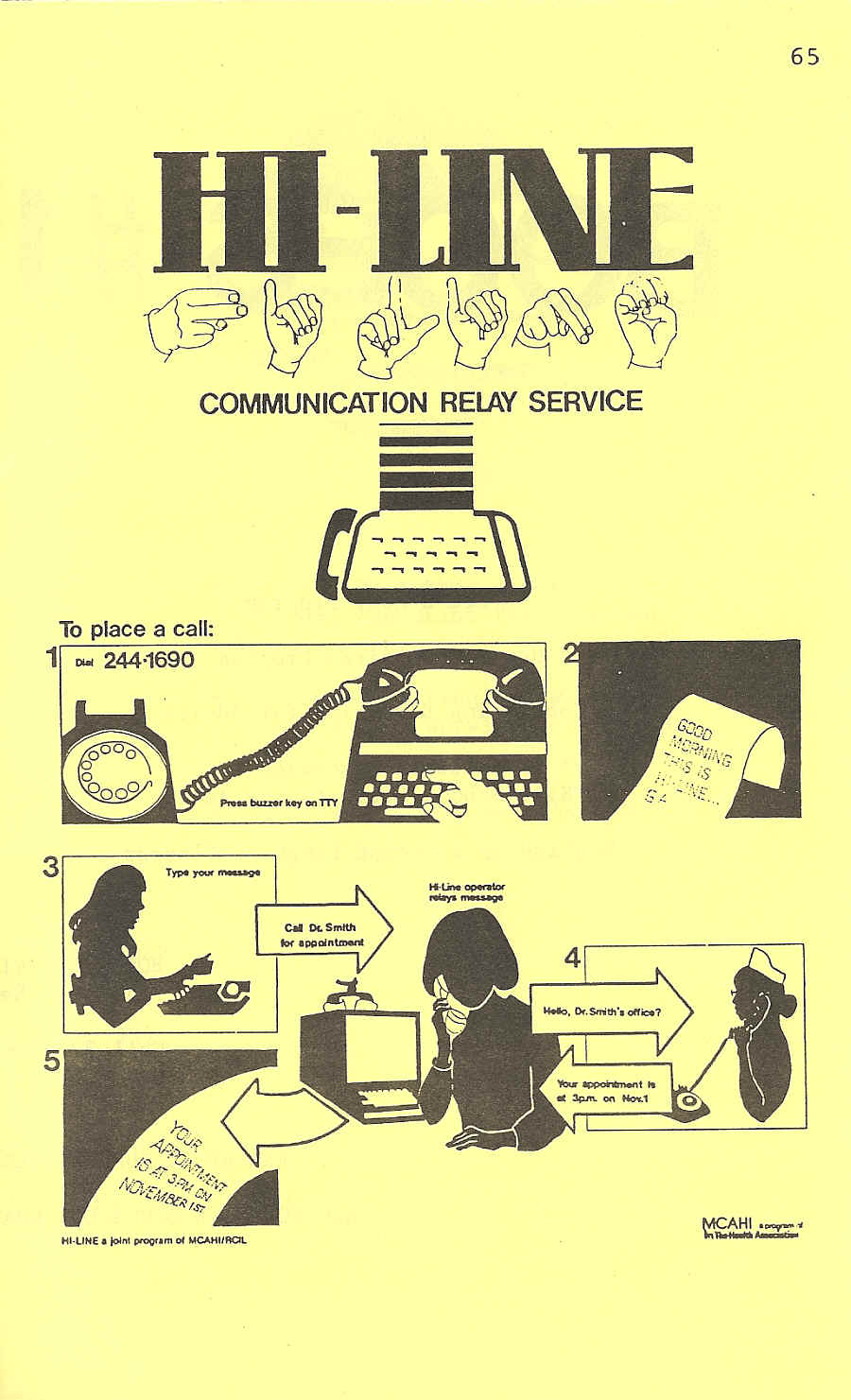
HI-LINE Communication Relay Service -
From RTCAD TTY/TDD Directory 1987 page 65 - From the Paul and Sally Taylor
Collection at SMECC
MCAHI
Monroe
County Association For the Hearing Impaired
A
program of the Health Association
MCAHI's
program and services are planned to assist the person with a
hearing impairment
and to alert the community to his/her special needs.
*
Advocacy
*
Information and referral
*
SOAR-HI Directory
*
HCAHI Newsletter
*
Hi-Line TDD Relay Service
*
Sign Language classes
*
Ear/Eye Screening
* And many more!
For
more information, call:
JacqueliI'.e
Schertz, Program Director MCAHI
973
East Avenue
Rochester, New York 14607
(716)
271-3540 V/TDD
(716)
271-8800 TDD Answering Machine
From RTCAD TTY/TDD Directory 1987 - From
the Paul and Sally Taylor Collection at SMECC |
|
|
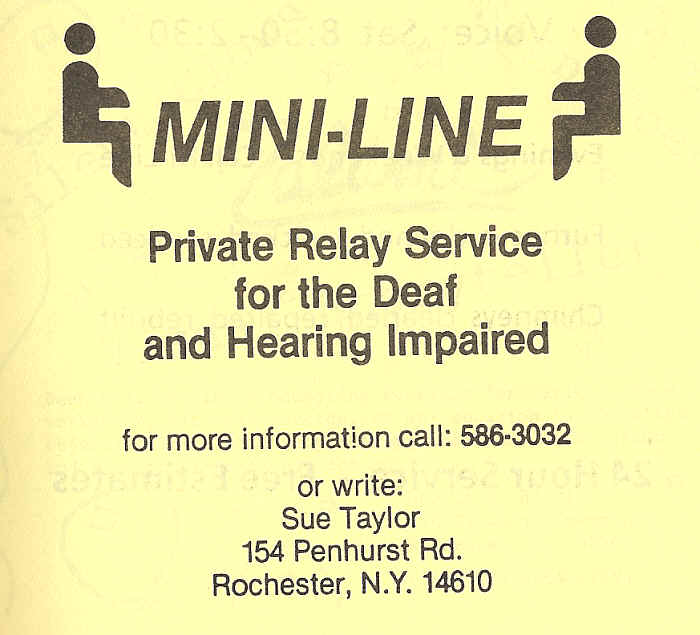
From RTCAD TTY/TDD Directory 1987 page
66 - From the Paul
and Sally Taylor Collection at SMECC
MINI-LINE
- Private Relay Service for
the Deaf and
Hearing Impaired - for
more information call: 586·3032 or write: Sue
Taylor 154 Penhurst Rd. Rochester,
N.Y. 14610
|
|
| Accessibility
for all |
| Relay
services for deaf people - reprinted from ITU
News - June 2011 |
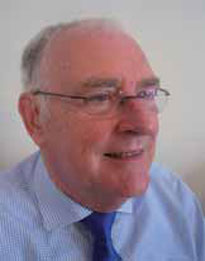 |
| photo credit: |
Christopher Jones,
co-Convener of the Joint Coordination Activity
on Accessibility and Human Factors (JCA-AHF) |
|
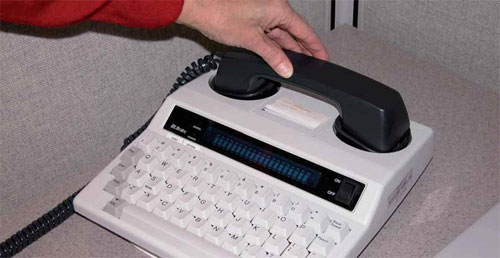 |
| Photo
credit: Ultratec |
Based on a contribution by Christopher Jones,
co-Convener of the Joint Coordination Activity on
Accessibility and Human Factors (JCA-AHF)
How do you make a phone call if you are deaf? Or,
more to the point, how do you respond to a call? Do
you have to ask your child or your neighbour to make
appointments for you or provide personal details to a
caller? Do you have to run out into the street looking
for someone to call an emergency service? These are
just some of the scenarios that a hearing person takes
for granted will not happen.
There are many different types of deafness:
profoundly deaf people who use only sign language;
profoundly deaf people who have intelligible speech;
profoundly deaf people who have less intelligible
speech; hearing people who are deafened; people who
are blind as well as deaf; and people who are hard of
hearing. People with age-related disabilities may fall
into any of these categories.
Many deaf people have problems in daily living by
not being able to make telephone calls to hearing
people or organizations without someone or something
in place to assist them. This is why relay services
are so important for deaf telecommunication. They are
professional services that do not rely on the kindness
of friends, family or strangers.
But while relay services have been around for more
than 40 years, most countries still do not offer these
services for deaf people, even though hearing
impairment is reportedly the most frequent sensory
deficit in human populations, affecting an estimated
250 million people in the world.
Today, being able to make contact by telephone is a
prerequisite for effective participation in society.
And the United Nations Convention on the Rights of
Persons with Disabilities provides for Full and
effective participation and inclusion in society.
From teleprinters to videophones and more
In the 1960s, deaf people started using
teleprinters (teletypewriters, also known as TTY) with
custom made acoustically coupled modems to communicate
with each other over the telephone network. The modems
used the ordinary telephone handset as the
transmitting device, thus enabling text to be sent
over the telephone network, character by character.
This was in real time and was the first real-time text
later standardized at ITU as part of Total
Conversation and used in the first accessibility
standard (ITUT V.18) for text phones.
Teletypewriters led to the development of text
telephones, which incorporated the printing device and
the modem in one portable unit.
When deaf people need to communicate with hearing
people who do not have text telephones, there is a
problem. Based on the work of the early pioneers (see
article How
the deaf developed a phone of their own), who were
all deaf, the response has been to develop a relay
service.
As technology progressed and the Internet
developed, it became possible for deaf people to
communicate with each other using video. This works
for deaf people who use sign language. Many deaf
people who have sign language as their first language
find it difficult to use text phones because they
require written language. Videophones have become
increasingly popular with these deaf users. They use
them to communicate with each other, and with hearing
people who can use sign language.
What is a relay service?
| |
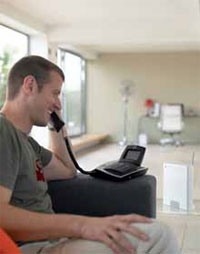 |
| Photo
credit: BT |
| Video
phones and text phones are among devices that
benefit from ITUs standardization work |
A relay service is simply a way of enabling a deaf
person using whatever modality they choose to
communicate with a hearing person, and vice versa
(Figure 1).
The modality used by the deaf caller may be text,
voice or sign. The different types of relay services
meet the different individual needs. These different
types of relay services for deaf people are: text
relay service; text relay service with voice carry
over; captioned telephone relay service; and video
relay service.
Text relay service
In a traditional text telephone relay service
(Figure 2), deaf callers use a bespoke text telephone
terminal to type the words that they want to say. A
more modern version uses the Internet, and is known as
an Internet Protocol (IP) relay service. This can be
accessed via a personal computer, laptop, personal
digital assistant or smartphone. Both use the same
operating method:
-
The deaf caller types his or her
communication to a text relay service centre,
where a relay operator will read aloud the typed
words to the hearing caller.
-
The hearing caller speaks to the
relay operator, who will transcribe the speech as
text, transmitting the typing back to the deaf
persons terminal, whether this is a text
telephone or an Internet device such as a laptop
or a smartphone.
Text relay service with voice carry over
For a deaf person who has speech that can be
understood by the hearing caller, the deaf person can
use a variant of a telephone relay service known as
voice carry over (Figure 3). Instead of typing the
words, the deaf person speaks directly to the hearing
caller. The hearing caller speaks to the relay
operator, who will transcribe the words as text, which
goes back to the deaf persons display screen. The
flow is either voice or text, but not both at the same
time.
Text relay services are available in many
countries, including the United States, Canada,
Australia, New Zealand, the United Kingdom, Sweden and
Denmark.
Captioned telephone relay service
A captioned telephone relay service (Figure 4) is
the most functionally equivalent and appropriate type
of relay service for people who are hard of hearing,
people who have been deafened, and deaf people whose
speech can be understood by hearing people. This is an
enhanced voice carry over system where a deaf person
has a normal telephone conversation in both directions
with the hearing caller.
The hearing persons speech path is split into
two: one path goes directly to the deaf caller, who
may understand most, some or none of the speech,
depending on their level of hearing loss or the level
of background noise. The other path goes to a
captioned telephone relay service centre, where a
captioning assistant will revoice everything the
hearing person says, word for word, into a voice
recognition engine. The transcribed text is
transmitted to the deaf users display, which could
be a laptop or a smartphone.
A captioned telephone relay service can be accessed
through the Internet using any browser device, such as
a personal computer, laptop, netbook, tablet, personal
digital assistant or smartphone.
Captioned telephone relay services are available in
the United States every hour of the day and night,
every day of the year. The cost to the user is the
same as the cost of a standard telephone call.
Australia is trialling a captioned telephone relay
service, and New Zealand has issued a tender for one.
Many people with age-related disabilities cannot
cope with computers; a bespoke captioned telephone is
what they need. This looks like a normal telephone but
with a large display to enable them to see transcribed
text from the hearing caller.
Video relay service
A video relay service (Figure 5) is used by deaf
people whose first language is sign language. Many of
these people do not have sufficient written language
skills to use text relay services. And they do not
have sufficiently intelligible speech to use a
captioned telephone relay service. They use either
videophones or a webcam on their personal computer,
laptop, tablet or smartphone (with the webcam in
front), together with videophone software or apps.
They sign their concepts to a video relay centre,
where a sign language interpreter will translate from
their sign language concepts into spoken language,
then voice over to the hearing caller. The hearing
caller speaks to the sign-language interpreter who
translates this into sign language for the deaf
caller.
Funding of relay services
Because a human interface is needed between the
deaf and hearing callers, relay services have to be
funded. These human interfaces might be text relay
service operators, captioned telephone relay service
captioning assistants, or video relay service
sign-language interpreters.
How can these services be funded? Each country has
different ways of funding the services. In some
countries, relay services are funded by government (as
in Sweden), in others they are funded either by the
telecommunications industry (for example, in the
United States) or as part of universal service (as in
the United Kingdom).
Costs in the United Kingdom
The text relay service in the United Kingdom is
more than 27 years old and uses old technology. The
service is currently under review, and a potential
provider of services commissioned research on the
economic benefits of a video relay service for deaf
sign-language users. According to the results of the
research, over a period of 10 years, providing a video
relay service will cost between GBP 734 million and
GBP 851 million, while the economic benefits to
society will amount to between GBP 996 million and GBP
1.1 billion.
Relay services do cost money, but the real benefits
to society outweigh these costs. Providing relay
services will result in increased employability and
improved health benefits for deaf people, and their
better integration into society.
Deaf children in developing countries
Imagine a rural village in Africa where a deaf
child is born to hearing parents. The parents would
need access to information about how to develop the
language ability of their child. Without such
information, the deaf child might remain isolated from
everyone in the village, because no one would be able
to communicate with him or her.
The power of telecommunications could break this
mould. Mobile Internet and solar-powered Internet
devices would offer the parents of the deaf child
enhanced access to information. Most importantly, the
deaf child could take part in social interaction via
video telephony, which could lead to better language
and literacy development. This would enable deaf
children to use future relay services, and would thus
improve their lives through social integration,
improved employability and better career prospects.
ITUs Telecommunication Development Sector (ITUD)
could work with the United Nations Childrens Fund
(UNICEF) to undertake an experimental project to
provide relay services for deaf children in developing
countries. This would be a powerful way of enhancing
these deaf childrens lives.
Conclusion
The technology of relay services has been
established for many years. Now countries need to
consider setting up relay services, where such
services do not already exist. The work of ITUs
Telecommunication Standardization Sector (ITUT) on
relay service standards is of paramount importance. It
is crucial to ensure that all deaf people are able to
communicate with anyone everywhere, just like their
hearing peers.
About Christopher Jones
In the early 1970s, Christopher Jones, who is
profoundly deaf, set up a local relay service using
24 teleprinters, having raised funds by making and
selling soft toys. The teleprinters, precursors to
text telephones, enabled local deaf people in the
United Kingdom to communicate across the telephone
network for the first time in their lives. Within a
couple of years, this led to the development of the
United Kingdoms second local text telephone relay
service, many years before the establishment of a
national text telephone relay service. Since 2007,
Christopher Jones has been Director of AccEquE Ltd,
a consulting company engaged in promoting enhanced
accessibility and equality in electronic
communications for deaf, deafened, deaf blind and
hard-of-hearing people.
|
|
Rochester School for the Deaf | Archive Center |
www.rsdeaf.org
1545 St. Paul Street | Rochester, New York 14621
|
GA-SK NEWSLETTER
T ELECOMMUNICATIONS
FOR THE DEAF INCORPORATED
A Publication for all TTY U sers
and Interested People
Volume
24 Number 4 Fall 1993
Page 10
VIPS Make Historic Relay
Calls
President
Clinton,
in an exciting demonstration of the new Federal Information Relay
Service (FIRS), placed a call through the system to mark the nationwide
availability of Telecommunications Relay Service. The service was
provided by Sprint through a General Services Administration contract.
Clinton,
during a White House meeting with leaders of the disability community,
used the federal relay service to call Cumming, Iowa, and speak with
Frank Harkin, brother of Sen. Tom Harkin, D-Iowa, the Senate sponsor of
the Americans with Disabilities Act of 1990, which became law three
years ago. Frank Harkin is deaf.
Among
other things, the FIRS provides people who use text telephones (TTY)
communications capabilities comparable to those available to hearing
individuals. FIRS is expected to increase employment and advancement
opportunities in the federal government for people who are deaf or hard
of hearing.
Global
communication took another giant step forward when former President
George Bush participated in a telecommunications relay service call
between the United States and Russia. Bush spoke from his office here
with Elizabeth Ann Boyd, a member of People to People International's
Education for the Hearing-Impaired Delegation to Rus ia, in St.
Petersburg. The call was handled by the AT&T Long Distance Relay
Service at 8:30 a.m. CDT.
"Who'
could have imagined that the ripple effect of our Americans with
Disabilities Act of 1990 would reach across the oceans so soon,"
said Bush. "This call will remind Americans about the relay system
in the United States. At the same time,
it
demonstrates to our Russian friends how our telephone relay system
works."
"I'm
so proud of the Citizen Ambassador Program of People to People
International and the way they are sharing our programs and technology
with other countries," he added.
"All
of us in the Hearing-Impaired Delegation of People to People's Citizen
Ambassador Program consider this call a very important milestone,"
said Boyd. "We believe international TTY relay calls between Russia
and the U.S. offer new communication and cultural-exchange opportunities
for people with disabilities in both countries. And we're grateful for
the telecommunications technology that makes the calls possible."
The
former president is the honorary chairman of People to People International,
a nonprofit organization founded in 1956 by President Dwight D.
Eisenhower to improve communications between Americans and the citizens
of other countries
. In 1990, then President Bush signed into law the Americans with
Disabilities Act, the most sweeping civil rights legislation since the
Civil Rights Act of 1964.
Boyd
is a computer programmer/analyst with the city of Houston. Her
participation in the delegation to Russia was made possible by
Southwestern Bell Telephone, which also
supplied two
text-telephone units to the U.S. Consulate in St. Petersburg for use
during the call. Southwestern Bell will donate the text-telephones to
Russian institutes for the deaf following the call.
TTY
users can reach the service by dialing 800-855-2880, standard telephone
users can dial 800-855-2881.
SK
|
|
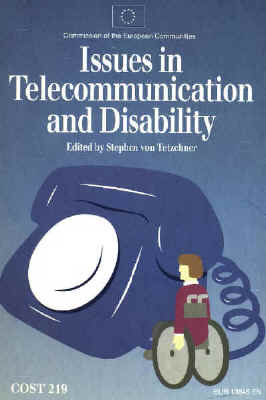
CDNA13845ENC_001.pdf
|
Commission of the European Communities
Information Technologies and sciences
COST 219
Issues in Telecommunication and Disability
Edited by
Stephen von Tetzchner
Norwegian Telecom Research Department
Directorate-General
Telecommunications, Information Industries
1991
|
The First Text Communication Devices: The USA
The implementation of personal text communication devices was mainly a result of
expensive equipment becoming obsolete, combined with some creative intervention.
In the beginning of the 1960s, the teletypewriters (telex machines) developed
26 The Short History of Text Telephones 239
early in the 1930s for document transmission, were beginning to be replaced with
more modern ones. In 1964, Robert Weitbrecht developed an acoustic coupler
that allowed two teletypewriters (usually called TTYs) to communicate over the
telephone network (Bellefleur, 1976).
The teletype machines were huge, weighed around 25 kilos and were not well
suited for a living room. The conversation was written on paper, which is probably
the reason why deaf people have got into the habit of demanding prints of conversations.
There was also a range of user-hostile features, such as independent carriage
return and linefeed, so that when the user forget to do both operations, there
would be a black mark at the end, or a new line of text over the previous one
(Geoffrion, 1982). But such matters were of minor importance for the users compared
to the fact that at last they had obtained access to personal telecommunication
without having to use an interpreter.
From 1964 to 1968, only 25 machines were operational, but from 1968 to 1975,
the number increased to about 5 000 units. Most of them were of the old type
which was designed some 40 years earlier. Little was done to modernise the equipment,
and although for the last ten years there has been talk about moving away
from the 5-bit Baudot code not used by many others in the world today (cf. Castle,
1981; Pflaum, 1982; Middleton, 1983), it is still this standard that is in common use
(there are couple of devices which can communicate with both ASCII and
Baudot). There have, of course, been newer models; in the 1970s, new, instead of
reconditioned equipment came on the market, and in 1980, there were 10-15
different manufacturers (Casde, 1981). New models are usually called TDDs (telecommunication
devices for the deaf). Some of these had hard print, others had
small displays, as well as automatic answering facilities, but in general, both functionality
and technical standards are the same as the out-of-date units 30 years ago.
The typical TDD today has a one or two line display with 32 characters and a transmission
rate of 45,5 bit/s.
It has been claimed that more modern equipment would have been more
expensive, and that this was the reason why Weitbrecht developed the TTY on outof-
date technology. Deaf people could get reconditioned surplus teletype equipment
relatively cheap; that is, initially the average price was $ 2 000, which by 1982
was reduced to $ 1 000 and to $ 500 in 1987 (House document No. 9, 1988; Levitt,
1982). Many deaf people belong to low-income groups, and even at this price, they
found the units hard to afford, and for example in the state of Virginia, in 1987,
only 27 per cent of potential users had a text telephone. This led to an initiative to
provide free text telephones to those who could document a need (House Document
No. 9, 1988).
On the other hand, the Baudot standard is extremely slow, and the user may
lose on the swing what he or she gains on the roundabout. The use of low cost TTY
machines represented a major step forward, but at the same time painted deaf
people into a corner by excluding them from communication with other possible
text communication devices, that is, in the USA, computers (Middleton, 1982).
A factor that has contributed to conserving the use of old-fashioned technology
is probably the fact that in several American states, telecommunication equipment
240 Communication by Text
is provided by the telecommunication companies at the same price as ordinary
equipment. For example, in 1979, Senate Bill 597 became law in California,
requiring telephone companies to provide text telephone devices to certified
hearing and speech impaired people free of charge (Pflaum, 1982). While applauding
this development, one should consider the risk that telephone companies do
not want to develop new equipment if this means higher distribution costs later.
Sendees
The first services to appear were emergency services where a call could be directed
to a hearing volunteer with a TTY who would then relay a message to the police,
hospital or fire brigade. In 1980, Bell Telephone Systems installed a special nationwide
toll-free TDD number that allowed TDD users to get assistance from a telephone
operator (Castle, 1981).
The first relay service was established in St. Louis in 1969 as part of a private
answering and wake-up service, serving 20 deaf families. The service was discontinued
after six month because the time it took to relay a conversation was much
longer than expected. A new service was started up in 1972 'when a volunteer organization
offered services which, even to this day, have been woefully inadequate in
meeting the telephone needs of the hearing impaired population in St. Louis'
(Taylor, 1989, p. 13).
A number of similar small operations appeared in the 1970s; some larger ones
were also established, such as the Hi-Line Relay Service of Rochester, New York,
which handled 163 497 calls in 1987. In spite of the large number of relayed calls,
with only 4 operators, the blockage rate was 30 per cent (Taylor, 1989). There is no
doubt that the lack of nation-wide, or at least state-wide, services have severely
hampered the possibilities of deaf and speech impaired people to make full use of
telecommunications.
The first state-wide service was opened in California in 1987, followed by Arizona
and Washington. In its first month, January 1987, the California relay service handled
87 511 calls, in January 1988, 200 718 calls were relayed, and the number of
operators were increased from the expected 60 to 120 persons (Shapiro, 1989). It
is worth noting that all of the first three state-wide services were a result of state
legislative action, indicating that this sort of major intervention, as relay services
represent, must come through legislative action.
With regard to relay services, the USA is still not one country. More than 300
relay services are geographically scattered with different names and telephone
numbers (Baquis, 1989). In 1989, 24 states had either established state wide relay
services or were in the process of legislation (Taylor, 1989). In 1991, there were 31
states with such relay services and 11 states are planning such services (Currie,
1991).
In addition to relay services, a number of commercial services appeared, some
of them very soon after the text telephone had arrived. In some shopping centres,
TTY shopping was possible, but it did not work well, and mistakes in the orders
were common. The National Railroad was also quick to establish a TTY service. It is
26 The Short History of Text Telephones 2 4 1
notable that this service is not yet available in Europe in 1991, without the help of a
relay service. Interestingly, a number of news centres for deaf people appeared, that
is, ±±. users could dial a special number and get a news print These services preceded
later teletext on television as well as today's visions of future newspaper
distribution. Additionally, a TTY radio news service was initiated in Philadelphia,
where the recipients had a small radio tuner, and the audio signal triggered the
11Y which printed out the message (Bellefleur and Bellefleur, 1979).
Development in Europe
While the development in the USA is reasonably well documented, there is a
scarcity of available information about the development in Europe. Several
countries that have text telephones are not mentioned in this review due to lack of
information. The introduction of equipment and services has been almost as piecemeal
as in the USA, with the exception that services were usually nationwide
when
initiated. There are still, however, many countries without text telephones, and
most European countries do not have a relay service (cf. chapter 22).
The first text telephones to be used in Europe were personal imports from the
USA, bought during travels abroad. However, the distribution was rather small,
and there is no record of any large number of deaf people being interconnected
with TDDs (Abbink and de Graaf, 1985).
The first country to manufacture and sell text telephones seem to be Germany
in 1976. This happened without any participation from government; the 'Deutsche
Schreibtelefon', which used the EDT standard (European Deaf Telephone) was
also sold in Austria, and, to some extent, in Switzerland.
Text telephones appeared early also in the UK, although there was never developed
a text communication device with deaf and speech impaired people in
mind. The British videotex system, Prestel, which was introduced in 1978, allowed
direct communication between individual users, and thus this was used for text
communication by deaf people. In 1986, a text communication device intended
for document transfer in offices based on V21 was adopted as text telephone by
deaf and speech impaired people. This system is currently the most widely used,
but there is still a considerable degree of incompatibility. The incompatibility has
even increased in 1990 and 1991 with the marketing of American TDDs based on
the Baudot standard in the UK and Ireland. Those who sold Baudotbased
text
telephones obviously disregarded the fact that text telephones of more modern
standards had already been on the market for several years, and one may assume
that not many people would have bought this equipment if they had known of the
incompatibility and that the relay service in the UK would not accept the Baudot
standard.
Around 1980, several countries started to manufacture text telephones. Sweden
began production of Diatext 1, which was based on V21, in 1979, and this text
telephone was adopted also in Finland and Norway shortly thereafter.
242 Communication by Text
In France, several 'telephone par ecrir' was commercially available in 1981; the
most known is Portatel. However, in 1982 the videotex system 'Minitel' was introduced,
and in the following years, the French Telecom gave away four million terminals
as electronic telephone directories. In 1986, Minitel Dialogue was introduced
to the benefit of deaf and speech impaired people. This model allowed direct
communication between two Minitel users if one of them used the Dialogue, and
Minitel has to a large extent replaced other text telephone devices (Besson, 1990;
Xech and Rimbault, 1987). The large number of terminals given away for free, and
the low charges of renting has made text communication widely available in
France, which is also reflected in the reduction of relay service use.
In the Netherlands, a trial with four text telephones was initiated in 1981 which
was followed by other small-scale trials until, in 1984, a commercial model based
on DTMF was presented on the market (Abbink and de Graaf, 1985).
Denmark performed some experimental trials with text telephones in 1979, but
they did not appear on the market until 1986, mainly because of funding
problems. The Danish text telephone was based on the Commodore +4, for which,
due to failing sales, the Danish Telecommunication Administrations got an
extremely advantageous offer (Dam, 1987). Somewhat surprisingly, in Denmark,
the DTMF was selected instead of the V21 which was already in use in the other
Nordic countries, except Iceland where the American text telephones based on the
Baudot standard had been in use since 1985. Iceland is presently in the process of
changing to computer-based text telephones and ASCII by adopting the Norwegian
text telephone program (cf. chapter 29).
Services
With a few noticeable exceptions, relay services in Europe are sdii in their infancy
or not even born (cf. chapter 22). The first European relay service seemed to have
started in the UK, where a pilot relay service was set up by the Royal National
Institute for the Deaf in London in 1980, but the further development was slow. In
1985, a regular service was launched under the name 'The RNID Telephone
Exchange for the Deaf (TED). That system could, however, only cater for 170
subscribers, which, of course, was vastly inadequate to serve the total population of
deaf and speech impaired people in the UK. Deaf and speech impaired people
had to wait for more than ten years, until 1991, before a unit was set up to handle
text communication nation-wide. This service is also run by The Royal National
Institute of the Deaf, and is independent from all the major national operators.
The first nation-wide or state-wide relay services ever, appeared in Finland and
Sweden. Finland had a trial service in 1981 that was made permanent in 1982, the
same year as Sweden started its service. Norway followed in 1984.
In the Netherlands, a small pilot service, serving a few deaf people, was set up in
1984, and after 2 years, a regular service was initiated. In Denmark, the relay service
started simultaneously with the introduction of the Danish text telephones,
that is, in 1986.
26 The Short History of Text Telephones 243
In Switzerland, t h e multilingual
situation seems to create certain problems. A
relay service was first initiated in the Germanspeaking
part of the country, in 1988,
while a relay service for the French speaking part was o p e n e d in 1989.
Learning from History
T h e lesson from history is that some sort of regulative action may be necessary to
ensure that disabled people get the equipment necessary to give them a m o r e
equal footing; that is, making society as accessible to them as possible. Both in
Europe a n d America, development has been slow, a n d there are considerably
fewer text telephones than people who need them.
T h e unfortunate situation in the UK, with three different a n d wholly incompatible
standards, amply demonstrates that commercial interests may be contradictory
to the interest of the consumers, a n d that there is a need to regulate the market in
order to establish the degree of telecommunication interchange that is expected in
m o d e r n society. It is hard to imagine a similar historical development, with lack of
interconnections between countries, for the ordinary audio telephone.
T h e long a n d frustrating road towards statewide
a n d nationwide
relay services
in the USA a n d the limited distribution of such services in Europe again demonstrates
the necessity of legislative action to obtain private or public funding for a
service that is a necessity for hearing and speech impaired people to obtain equal
access to telecommunication. In the USA, sufficient relay services have in most
cases come only after legislative action, a n d as Europe is moving towards increased
liberalisation, similar development may be expected there.
References
ABBINK, G.A. & de Graaf, J.E. (1985). Text telephone, a telephone system for people with
defective hearing. PTTBerijf,
23, 4755.
BAQUIS, D. (1989). TDD relay services across the United States. In J.E. Harkins and B.M.
Virvan (Eds.), Speech today and tomorrow: Proceedings of a conference at Gallaudet University,
September 1988. Washington: Gallaudet University, pp. 2543.
BELLEFLEUR, K.M. 8C Bellefleur, P.A. (1979). RadioTTY:
a community mass media system
for the deaf. The Volta Review, 81, 3539.
BELLEFLEUR, P.A. (1976). ±±. communications: its history and future. The Volta Review, 78,
107112.
BESSON, R. (1990). Minitel for people with disabilities. Proceedings of the Second European Conference
on Policy Related to Telematics and Disability, pp. 106109.
CASTLE, D.L. (1981). Telecommunication and the hearing impaired. The Volta Review, 83,
275284.
CURRIE, K. (1991). Personal communication.
GEOFFRION, L.D. (1982). The ability of hearingimpaired
students to communicate using a
teletype system. The Volta Review, 84, 96108.
244 Communication by Text
HOUSE DOCUMENT NO. 9. (1988). Equal telecommunications access for deaf hard of
hearing Virginians (TDD/Message relay programs). Richmond: Commomwealth of
Virginia.
LEVITT, H. (1982). The use of a pocket computer as an aid for the deaf. American AnnaLE oj
the Deaf, 727,559-563.
MlDDLETON, T. (1983). DEAFNET - The word's getting around: local implementation of
telecommunications network for deaf users. American AnnaLE of the Deaf, 128, 613-618.
PKLAUM, M.E. (1982). The California connection: Interfacing a Telecommunication for the
Deaf (TDD) and an Apple computer. American AnnaLE of the Deaf, 127, 573-584.
SHAPIRO, P. (1989). California relay service. In J.E. Harkins and B.M. Virvan (Eds.), Speech
today and tomorrow: Proceedings of a conference at Gallandet University, September 1988.
Washington: Gallaudet University, pp. 85-88.
TAYLOR, P.L. (1989). Telephone relay service: rationale and overview. In J.E. Harkins and
B.M. Virvan (Eds.), Speech today and tomorrow: Proceedings of a conference at Gallaudet University,
September 1988. Washington: Gallaudet University, pp. 11-18.
XECH, S. & Mathon, C. (1987). Le Minitel Dialogue: un nouveau moyen de communication
a distance au service des personnes atteintes de surdite severe ou profonde. Thesis,
University of Paris.
Chapter 26: The Short History of Text Telephones
Stephen von Tetzchner
When Bell invented the telephone in 1876, this represented a crucial step in the history of telecommunications; the introduction of the telephone made it possible for the general public to use their own voice to communicate over a distance instead of having to write down messages and ask a telegraph operator to relay them to the other part. For some people, that is, for those who cannot hear or speak, the general development implied a more difficult situation because they were unable to use telecommunication in the same manner as others. They were not able to take part in many new developments in society, because they lacked the possibility of direct communication with people at other geographical locations. While society at large changed, the communication patterns of deaf and speech impaired people remained very much the same.
However, it is not, of course, the development of audio telephones in itself that should be
criticised, but the lack of interest for the situation of those who could not use this service. After all, the first telecommunication service, the telegraph, was based on transmission of letters, and from the perspective of speech and hearing impaired people, it seems rather surprising that it should take almost one hundred years before text communication was made available for personal use.
The short history of the text telephone, compared to the history of the audio telephone, started in the USA, where the first text telephone, or a least an approximation of it, was "invented" in 1964. As has often been the case with new developments for, and movements of, disabled people, Europe was somewhat later on the stage than the USA. But equally typical, Europe has caught up, and today, several European countries have better equipment and services than the USA.
1 The First Text Communication Devices: The USA
The implementation of personal text communication devices was mainly a result of expensive equipment becoming obsolete, combined with some creative intervention. In the beginning of the 1960s, the teletypewriters (telex machines) developed early in the 1930s for document transmission, were beginning to be replaced with more modern ones. In 1964, Robert Weitbrecht developed an acoustic coupler that allowed two teletypewriters (usually called TTY) to communicate over the telephone network
(Bellefleur, 1976).
The teletype machines were huge, weighed around 25 kilos and were not well suited for a living room. The conversation was written on paper, which is probably the reason why deaf people have got into the habit of demanding prints of conversations. There was also a range of user-hostile features, such as independent carriage return and linefeed, so that when the user forget to do both operations, there would be a black mark at the end, or a new line of text over the previous one
(Geoffrion, 1982). But such matters were of minor importance for the users compared to the fact that at last they had obtained access to personal telecommunication without having to use an interpreter.
From 1964 to 1968, only 25 machines were operational, but from 1968 to 1975, the number increased to about 5 000 units. Most of them were of the old type which was designed some 40 years earlier. Little was done to modernise the equipment, and although for the last ten years there has been talk about moving away from the 5-bit Baudot code not used by few others in the world today (cf. Castle, 1981;
Pflaum, 1982; Middleton, 1983), it is still this standard that is in common use (there are couple of devices which can communicate with both ASCII and
Baudot). There have, of course, been newer models; in the 1970s, new, instead of reconditioned equipment came on the market, and in 1980, there were 10-15 different manufacturers (Castle, 1981). New models are usually called TDD (telecommunication devices for the deaf). Some of these had hard print, others had small displays, as well as automatic answering facilities, but in general, both functionality and technical standards are the same as the out-of-date units 30 years ago. The typical TTY today has a one or two line display with 32 characters and a transmission rate of 45,5 bit/s.
It has been claimed that more modern equipment would have been more expensive, and that this was the reason why Weitbrecht developed the TTY on out-of-date technology. Deaf people could get reconditioned surplus teletype equipment relatively cheap; that is, initially the average price was $ 2 000, which by 1982 was reduced to $ 1 000 and to $ 500 in 1987 (House document No. 9, 1988;
Levitt, 1982). Many deaf people belong to low- income groups, and even at this price, they found the units hard to afford, and for example in the state of Virginia, in 1987, only 27 per cent of potential users had a text telephone. This led to an initiative to provide free text telephones to those who could document a need (House Document No. 9, 1988).
On the other hand, the Baudot standard is extremely slow, and the user may lose on the swing what he or she gains on the roundabout. The use of low cost TTY machines represented a major step forward, but at the same time painted deaf people into a corner by excluding them from communication with other possible text communication devices, that is, in the USA, computers (Middleton, 1982).
A factor that has contributed to conserving the use of old-fashioned technology is probably the fact that in several American states, telecommunication equipment is provided by the telecommunication companies at the same price as ordinary equipment. For example, in 1979, Senate Bill 597 became law in California, requiring telephone companies to provide text telephone devices to certified hearing and speech impaired people free of charge
(Pflaum, 1982). While applauding this development, one should consider the risk that telephone companies do not want to develop new equipment if this means higher distribution costs later.
1.1 Services
The first services to appear were emergency services where a call could be directed to a hearing volunteer with a TTY who would then relay a message to the police, hospital or fire brigade. In 1980, Bell Telephone Systems installed a special nation-wide toll-free TDD number that allowed TDD users to get assistance from a telephone operator (Castle, 1981).
The first relay service was established in St. Louis in 1969 as part of a private answering and wake-up service, serving 20 deaf families. The service was discontinued after six month because the time it took to relay a conversation was much longer than expected. A new service was started up in 1972 "when a volunteer organization offered services which, even to this day, have been woefully inadequate in meeting the telephone needs of the hearing impaired population in St. Louis" (Taylor, 1989, p. 13).
A number of similar small operations appeared in the 1970s; some larger ones were also established, such as the Hi-Line Relay Service of Rochester, New York, which handled 163 497 calls in 1987. In spite of the large number of relayed calls, with only 4 operators, the blockage rate was 30 per cent (Taylor, 1989). There is no doubt that the lack of nation-wide, or at least state-wide, services have severely hampered the possibilities of deaf and speech impaired people to make full use of telecommunications.
The first state-wide service was opened in California in 1987, followed by Arizona and Washington. In its first month, January 1987, the California relay service handled 87 511 calls, in January 1988, 200 718 calls were relayed, and the number of operators were increased from the expected 60 to 120 persons (Shapiro, 1989). It is worth noting that all of the first three state-wide services were a result of state legislative action, indicating that this sort of major intervention, as relay services represent, must come through legislative action.
With regard to relay services, the USA is still not one country. More than 300 relay services are geographically scattered with different names and telephone numbers
(Baquis, 1989). In 1989, 24 states had either established state wide relay services or were in the process of legislation (Taylor, 1989). In 1991, there were 31 states with such relay services and 11 states are planning such services (Currie, 1991).
In addition to relay services, a number of commercial services appeared, some of them very soon after the text telephone had arrived. In some shopping
centres, TTY shopping was possible, but it did not work well, and mistakes in the orders were common. The National Railroad was also quick to establish a TTY service. It is notable that this service is not yet available in Europe in 1991, without the help of a relay service. Interestingly, a number of news centres for deaf people appeared, that is, TTY users could dial a special number and get a news print. These services preceded later teletext on television as well as today's visions of future newspaper distribution. Additionally, a TTY radio news service was initiated in Philadelphia, where the recipients had a small radio tuner, and the audio signal triggered the TTY which printed out the message
(Bellefleur and Bellefleur, 1979).
2 Development in Europe
While the development in the USA is reasonably well documented, there is a scarcity of available information about the development in Europe. Several countries that have text telephones are not mentioned in this review due to lack of information. The introduction of equipment and services has been almost as piecemeal as in the USA, with the exception that services were usually nation-wide when initiated. There are still, however, many countries without text telephones, and most European countries do not have a relay service (cf. chapter 22).
The first text telephones to be used in Europe were personal imports from the USA, bought during travels abroad. However, the distribution was rather small, and there is no record of any large number of deaf people being interconnected with TDDs
(Abbink and de Graaf, 1985).
The first country to manufacture and sell text telephones seem to be Germany in 1976. This happened without any participation from government; the "Deutsche
Schreibtelefon", which used the EDT standard (European Deaf Telephone) was also sold in Austria, and, to some extent, in Switzerland.
Text telephones appeared early also in the UK, although there was never developed a text communication device with deaf and speech impaired people in mind. The British videotex system,
Prestel, which was introduced in 1978, allowed direct communication between individual users, and thus this was used for text communication by deaf people. In 1986, a text communication device intended for document transfer in offices based on V21 was adopted as text telephone by deaf and speech impaired people. This system is currently the most widely used, but there is still a considerable degree of incompatibility. The incompatibility has even increased in 1990 and 1991 with the marketing of American TDDs based on the Baudot standard in the UK and Ireland. Those who sold
Baudot-based text telephones obviously disregarded the fact that text telephones of more modern standards had already been on the market for several years, and one may assume that not many people would have bought this equipment if they had known of the incompatibility and that the relay service in the UK would not accept the Baudot standard.
Around 1980, several countries started to manufacture text telephones. Sweden began production of Diatext 1, which was based on V21, in 1979, and this text telephone was adopted also in Finland and Norway shortly thereafter.
In France, several "tlphone par crir" was commercially available in 1981; the most known is
Portatel. However, in 1982 the videotex system "Minitel" was introduced, and in the following years, the French Telecom gave away four million terminals as electronic telephone directories. In 1986, Minitel Dialogue was introduced to the benefit of deaf and speech impaired people. This model allowed direct communication between two Minitel users if one of them used the Dialogue, and Minitel has to a large extent replaced other text telephone devices
(Besson, 1990; Xech and Rimbault, 1987). The large number of terminals given away for free, and the low charges of renting has made text communication widely available in France, which is also reflected in the reduction of relay service use.
In the Netherlands, a trial with four text telephones was initiated in 1981 which was followed by other small-scale trials until, in 1984, a commercial model based on DTMF was presented on the market
(Abbink and de Graaf, 1985).
Denmark performed some experimental trials with text telephones in 1979, but they did not appear on the market until 1986, mainly because of funding problems. The Danish text telephone was based on the Commodore +4, for which, due to failing sales, the Danish Telecommunication Administrations got an extremely advantageous offer (Dam, 1987). Somewhat surprisingly, in Denmark, the DTMF was selected instead of the V21 which was already in use in the other Nordic countries, except Iceland where the American text telephones based on the Baudot standard had been in use since 1985. Iceland is presently in the process of changing to computer-based text telephones and ASCII by adopting the Norwegian text telephone program (cf. chapter
xx).
2.1 Services
With a few noticeable exceptions, relay services in Europe are still in their infancy or not even born (cf. chapter 22). The first European relay service seemed to have started in the UK, where a pilot relay services was set up by the Royal National Institute for the Deaf in London in 1980, but the further development was slow. In 1985, a regular service was launched under the name "The RNID Telephone Exchange for the Deaf" (TED). That system could, however, only cater for 170 subscribers, which, of course, was vastly inadequate to serve the total population of deaf and speech impaired people in the UK. Deaf and speech impaired people had to wait for more than ten years, until 1991, before a unit was set up to handle text communication nation-wide. This service is also run by The Royal National Institute of the Deaf, and is independent from all the major national operators.
The first nation-wide or state-wide relay services ever, appeared in Finland and Sweden. Finland had a trial service in 1981 that was made permanent in 1982, the same year as Sweden started its service. Norway followed in 1984.
In the Netherlands, a small pilot service, serving a few deaf people, was set up in 1984, and after 2 years, a regular service was initiated. In Denmark, the relay service started simultaneously with the introduction of the Danish text telephones, that is, in 1986.
In Switzerland, the multi-lingual situation seems to create certain problems. A relay service was first initiated in the German-speaking part of the country, in 1988, while a relay service for the French speaking part was opened in 1989.
3 Learning from History
The lesson from history is that some sort of regulative action may be necessary to ensure that disabled people get the equipment necessary to give them a more equal footing; that is, making society as accessible to them as possible. Both in Europe and America, development has been slow, and there are considerably fewer text telephones than people who need them.
The unfortunate situation in the UK, with three different and wholly incompatible standards, amply demonstrates that commercial interests may be contradictory to the interest of the consumers, and that there is a need to regulate the market in order to establish the degree of telecommunication interchange that is expected in modern society. It is hard to imagine a similar historical development, with lack of interconnections between countries, for the ordinary audio telephone.
The long and frustrating road towards state-wide and nation-wide relay services in the USA and the limited distribution of such services in Europe again demonstrates the necessity of legislative action to obtain private or public funding for a service that is a necessity for hearing and speech impaired people to obtain equal access to telecommunication. In the USA, sufficient relay services have in most cases come only after legislative action, and as Europe is moving towards increased
liberalisation, similar development may be expected there.
References:
Abbink & de Graaf
Baquis, D. (1989). TDD relay services across the United States. In J.E. Harkins and
B.M. Virvan (Eds.), Speech today and tomorrow: Proceedings of a conference at Gallaudet University, September 1988. Washington: Gallaudet University, pp. 25-43.
Bellefleur, K.M. & Bellefleur, P.A. (1979). Radio-TTY: a community mass media system for the deaf. The Volta Review, 81, 35-39.
Bellefleur, P.A. (1976). TTY communications: its history and future. The Volta Review, 78, 107-112.
Besson, R. (1990). Minitel for people with disabilities. Proceedings of the Second European Conference on Policy Related to Telematics and Disability, pp. 106-109.
Castle, D.L. (1981). Telecommunication and the hearing impaired. The Volta Review, 83, 275-284.
Currie, K. (1991). Personal communication.
Geoffrion, L.D. (1982). The ability of hearing-impaired students to communicate using a teletype system. The Volta Review, 84, 96-108.
House Document No. 9. (1988). Equal telecommunications access for deaf hard of hearing Virginians
(TDD/Message relay programs). Richmond: Commomwealth of Virginia.
Levitt, H. (1982). The use of a pocket computer as an aid for the deaf. American Annals of the Deaf, 127, 559-563.
Middleton, T. (1983). DEAFNET - The word's getting around: local implementation of telecommunications network for deaf users. American Annals of the Deaf, 128, 613-618.
Pflaum, M.E. (1982). The California connection: Interfacing a Telecommunication for the Deaf
(TDD) and an Apple computer. American Annals of the Deaf, 127, 573-584.
Shapiro, P. (1989). California relay service. In J.E. Harkins and B.M. Virvan (Eds.), Speech today and tomorrow: Proceedings of a conference at Gallaudet University, September 1988. Washington: Gallaudet University, pp. 85-88.
Taylor, P.L. (1989). Telephone relay service: rationale and overview. In J.E. Harkins and
B.M. Virvan (Eds.), Speech today and tomorrow: Proceedings of a conference at Gallaudet University, September 1988. Washington: Gallaudet University, pp. 11-18.
Xech, S. & Mathon, C. (1987). Le Minitel Dialogue: un nuveau moyen de communication
distance au service des personnes atteintes de
surdit svre ou profonde. Thesis, University of Paris.
|
|
|
|
|
|
|
|
|
|
|
|
|
|
|
|
 While
they worked with deaf people at a local church, Bill and Grace realized
that the vast majority of the deaf community were without telephones and
TTYs. They obtained a grant to distribute TTYs to the deaf and hard of
hearing population in Connecticut. David, their son joined them to run
their business.
While
they worked with deaf people at a local church, Bill and Grace realized
that the vast majority of the deaf community were without telephones and
TTYs. They obtained a grant to distribute TTYs to the deaf and hard of
hearing population in Connecticut. David, their son joined them to run
their business.















